External Environment. External Environment Thus far our discussion
















































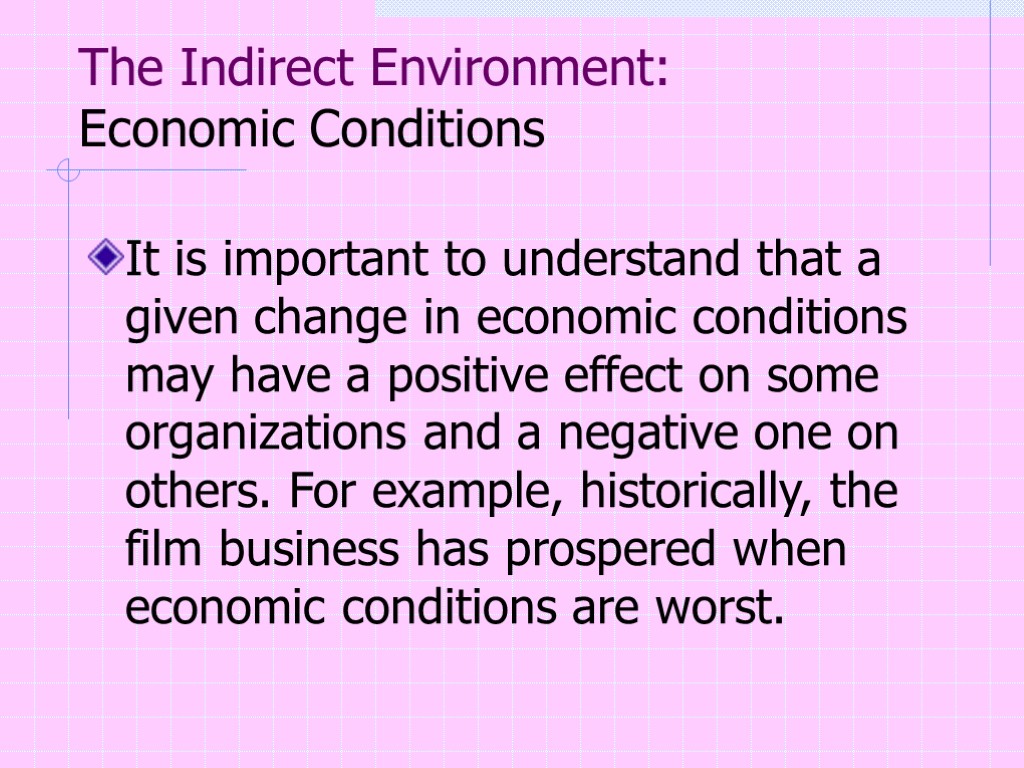




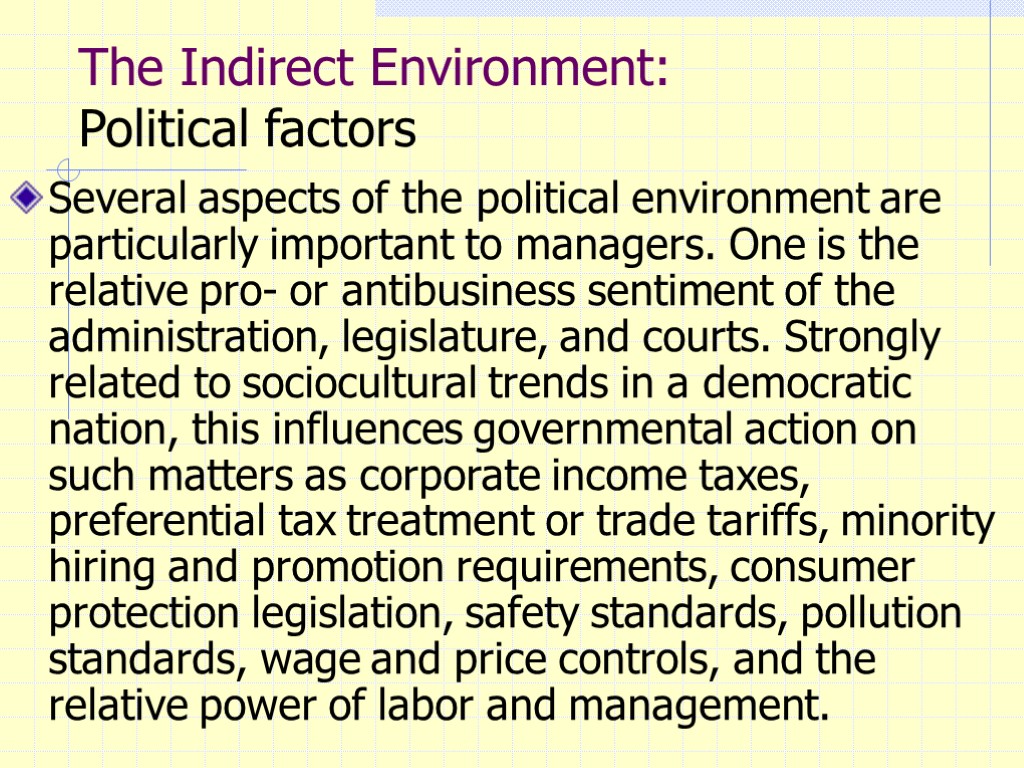
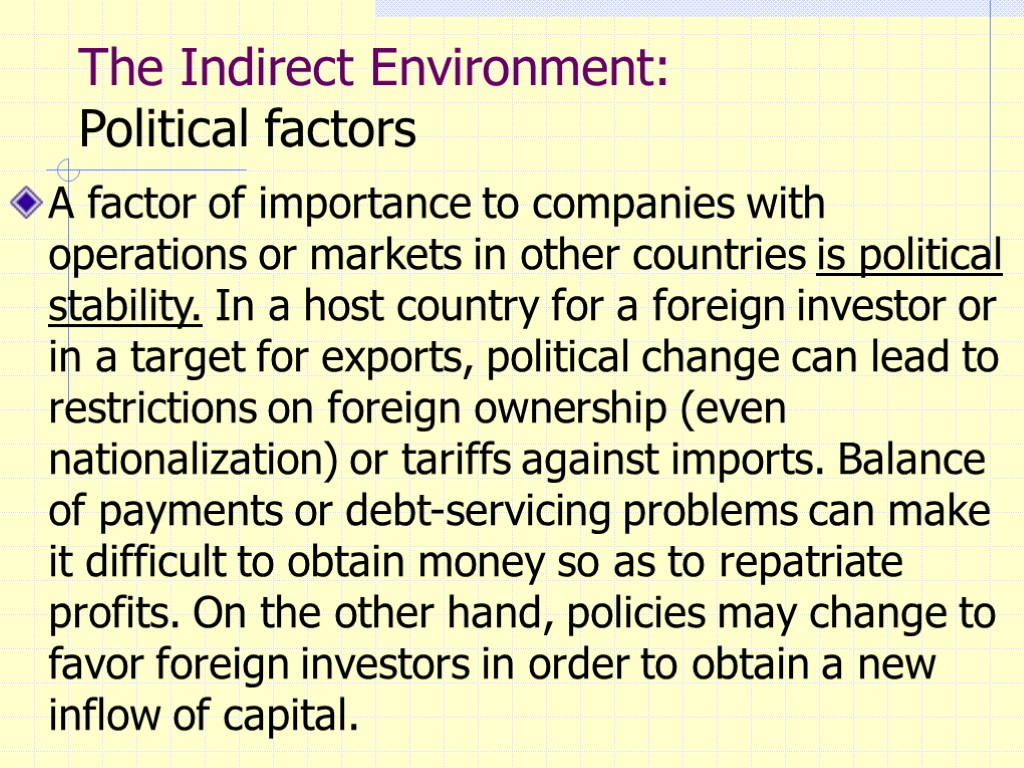
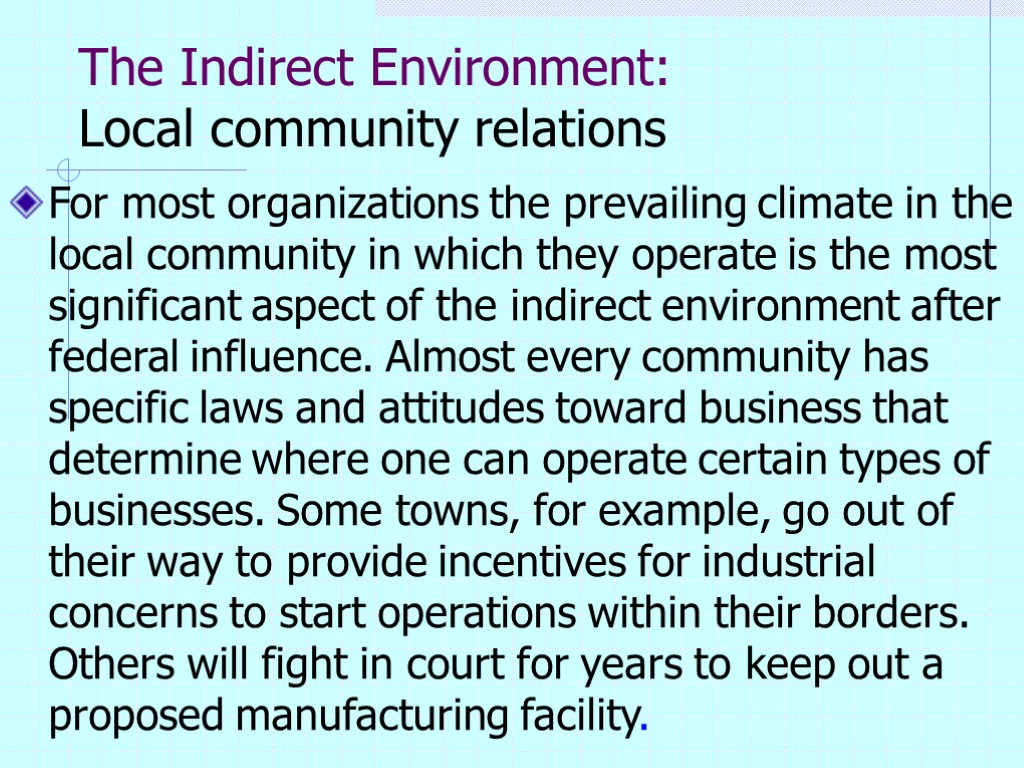

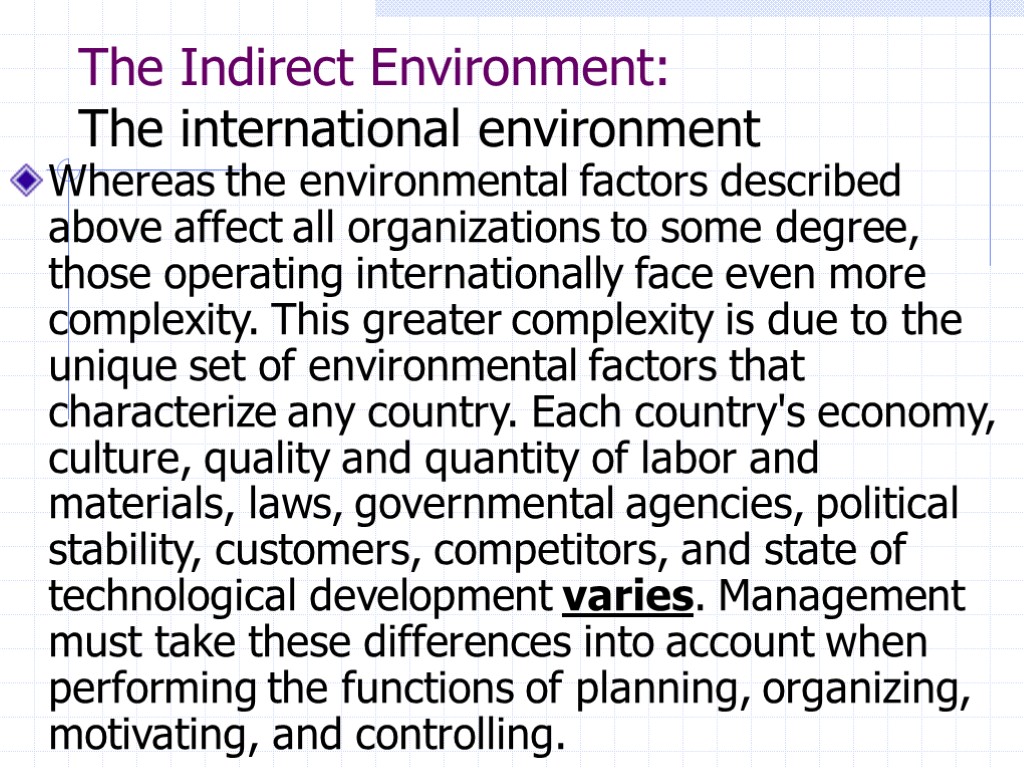
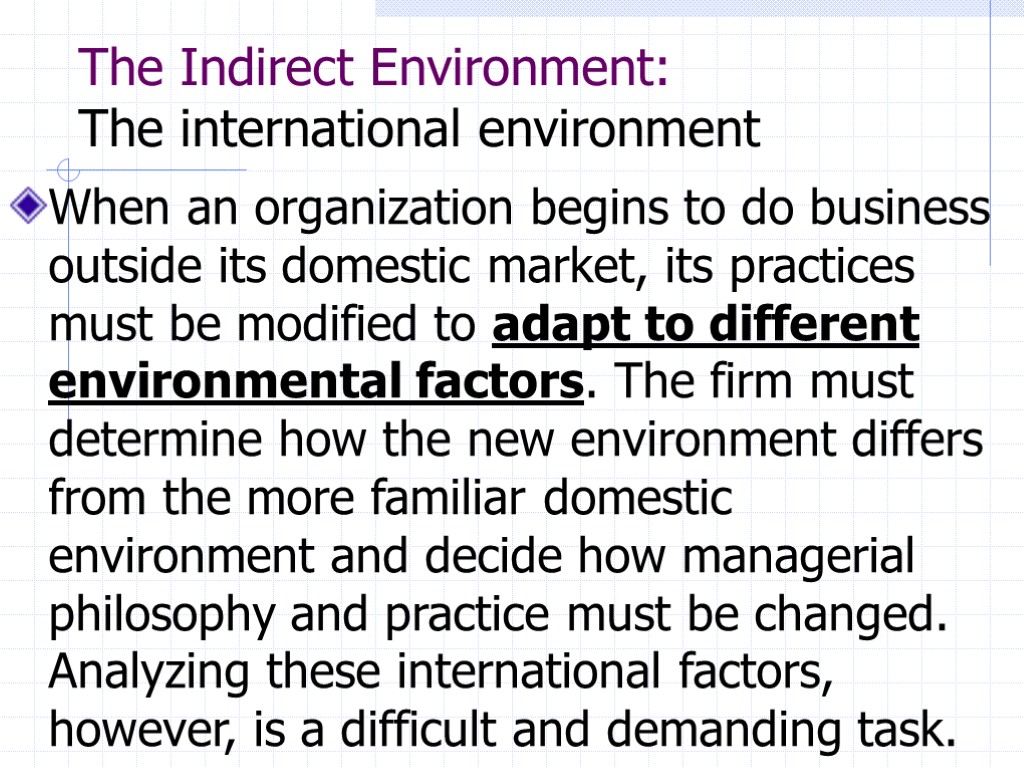
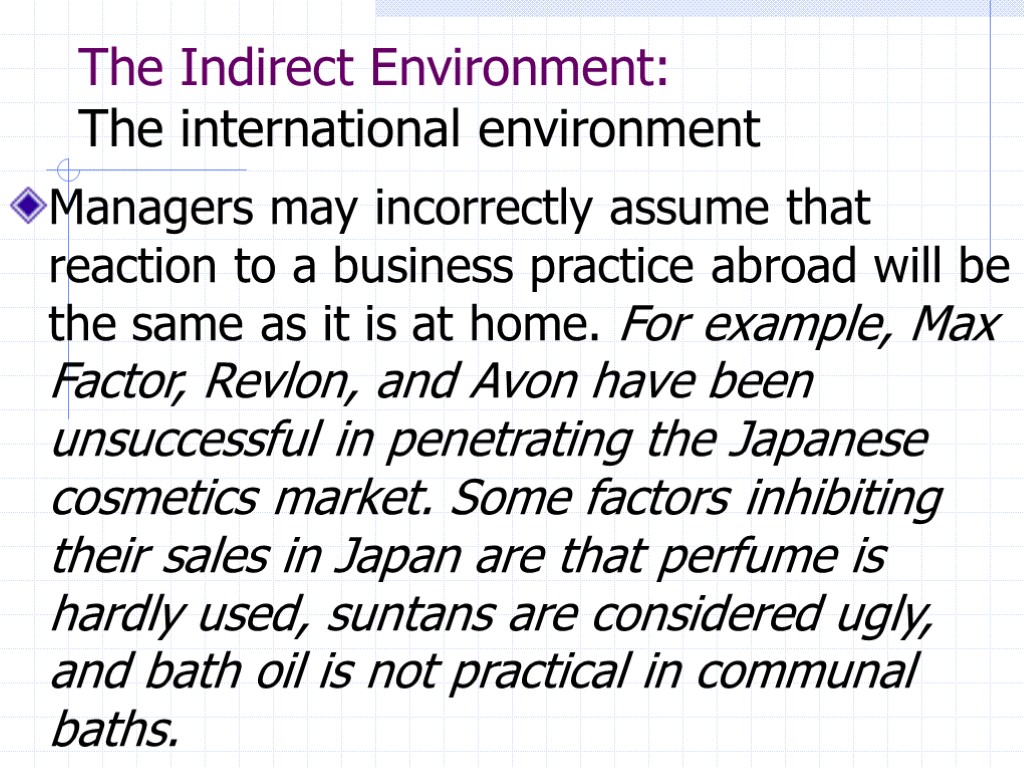
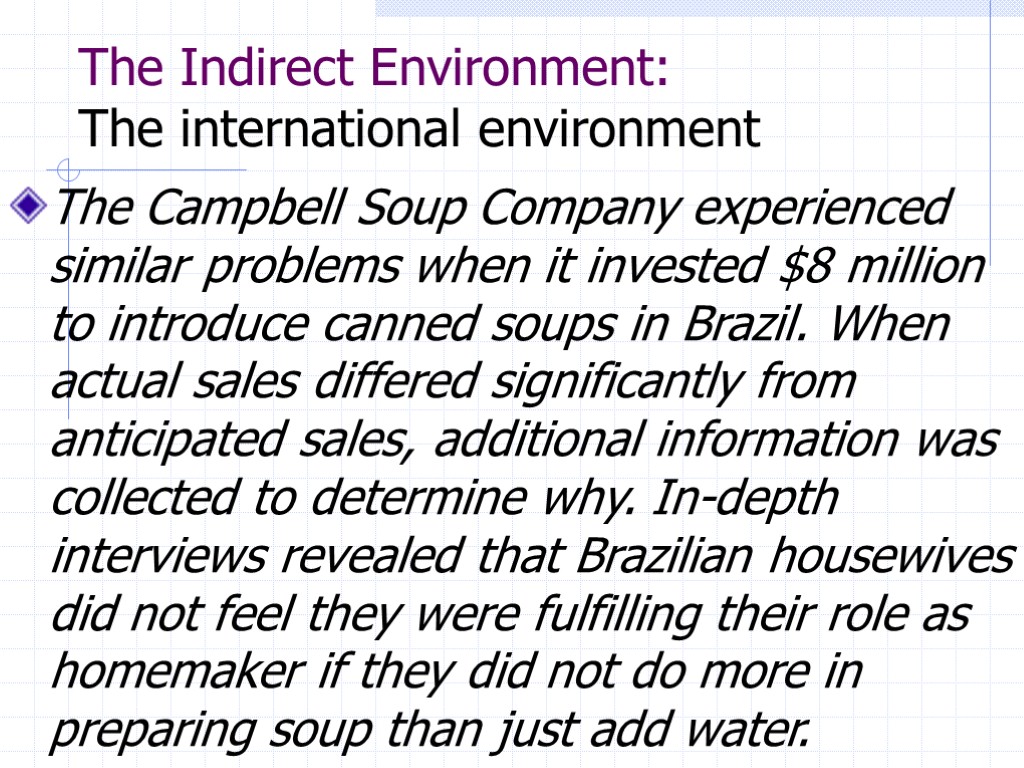
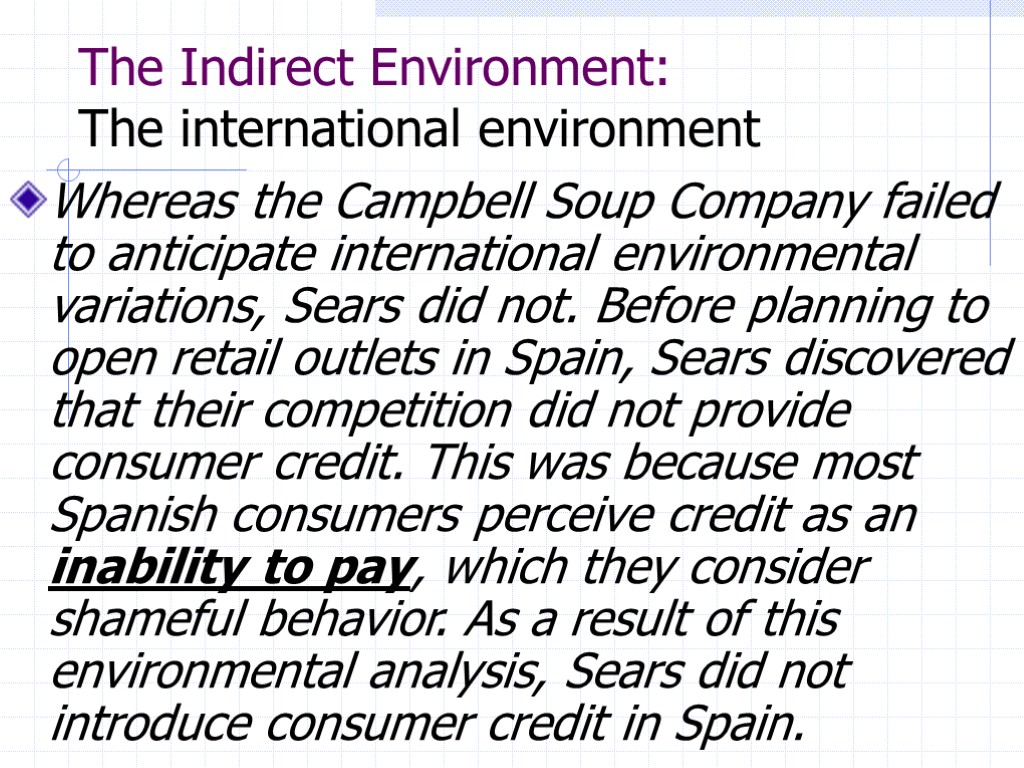
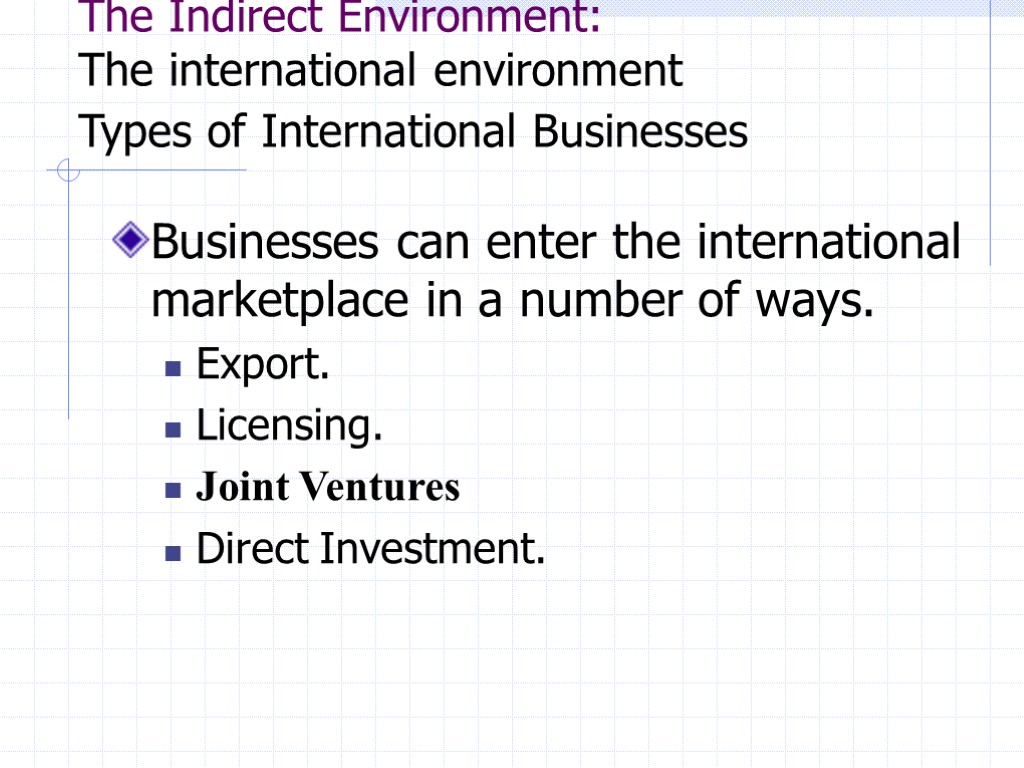
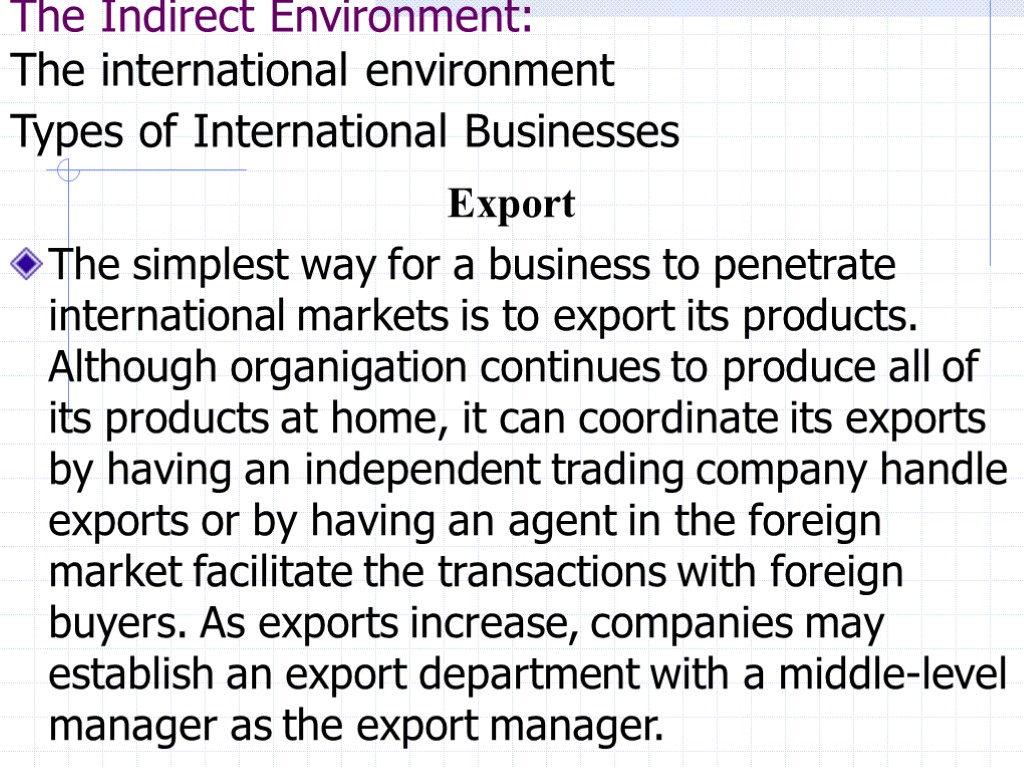

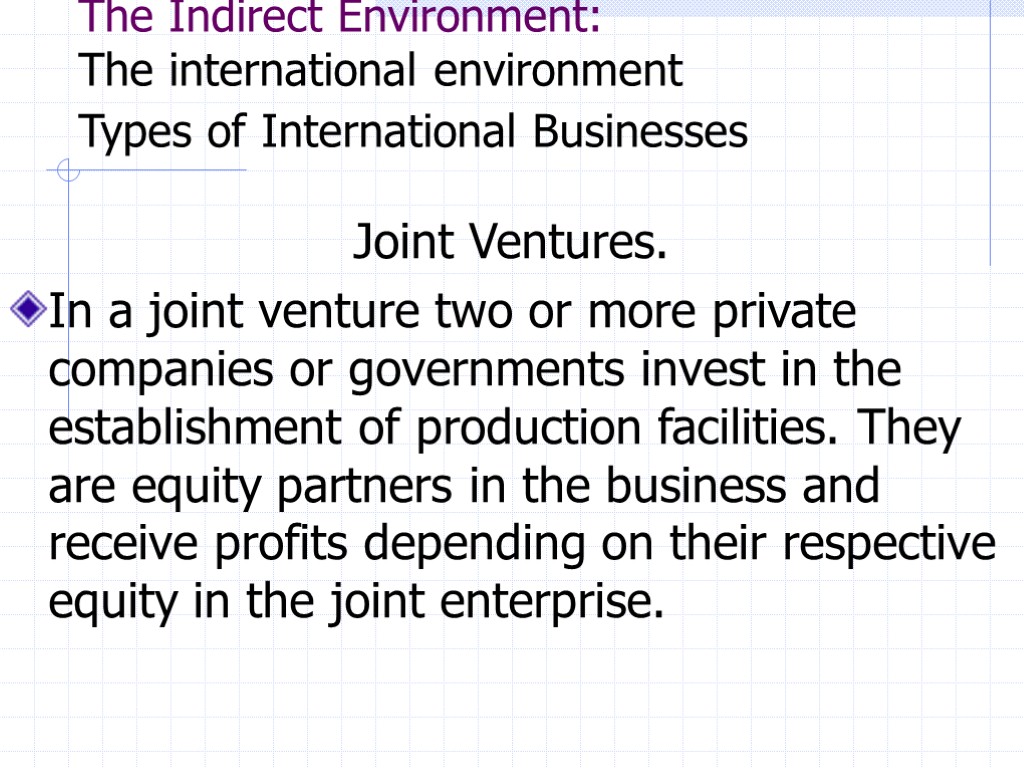
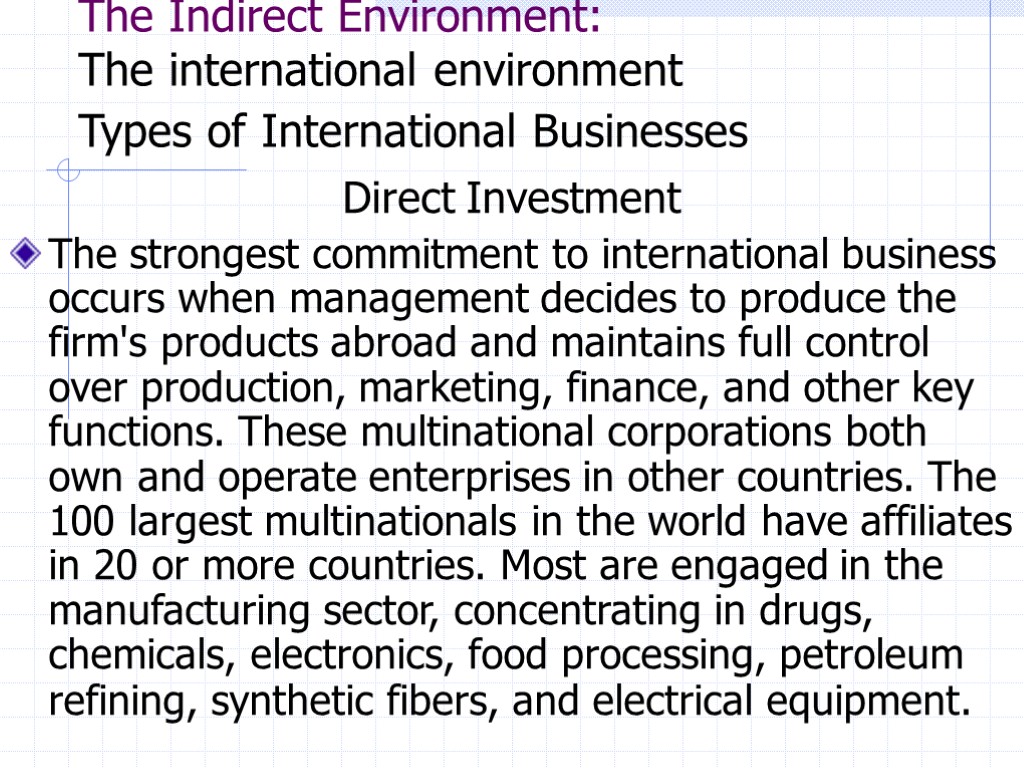
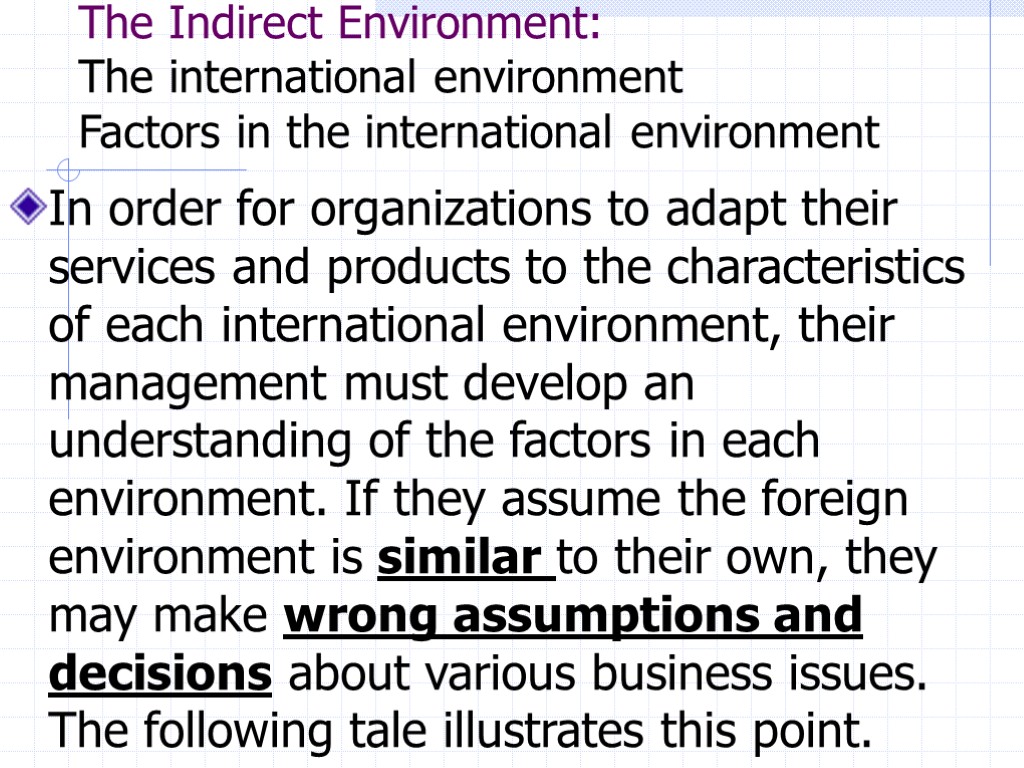
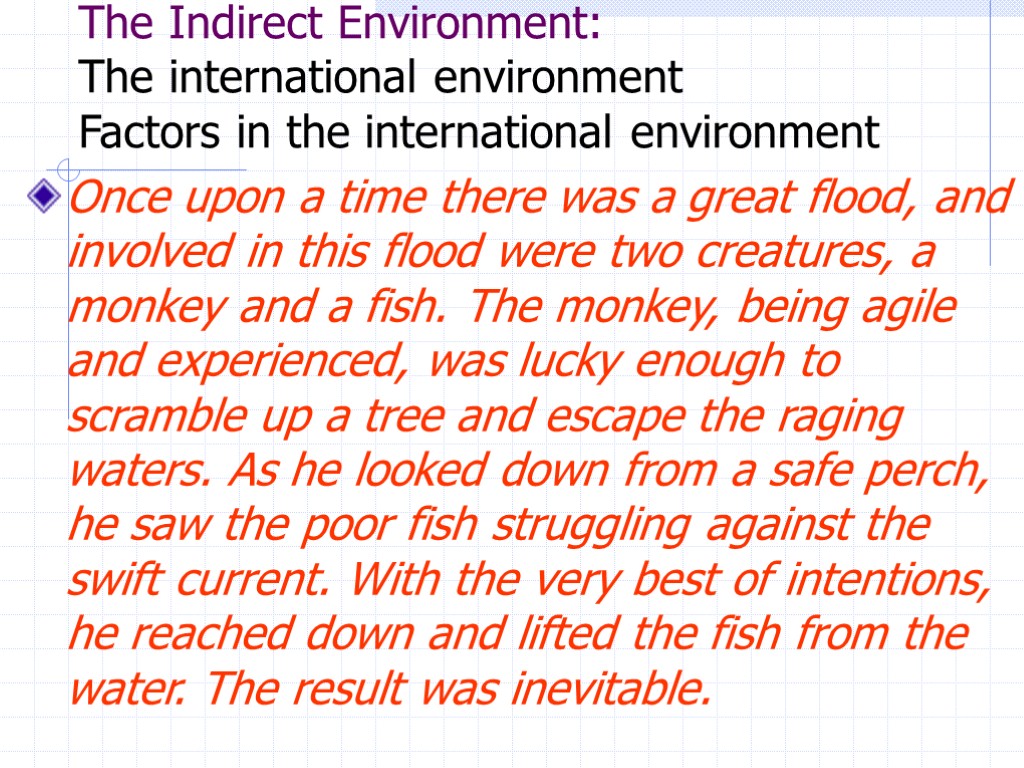
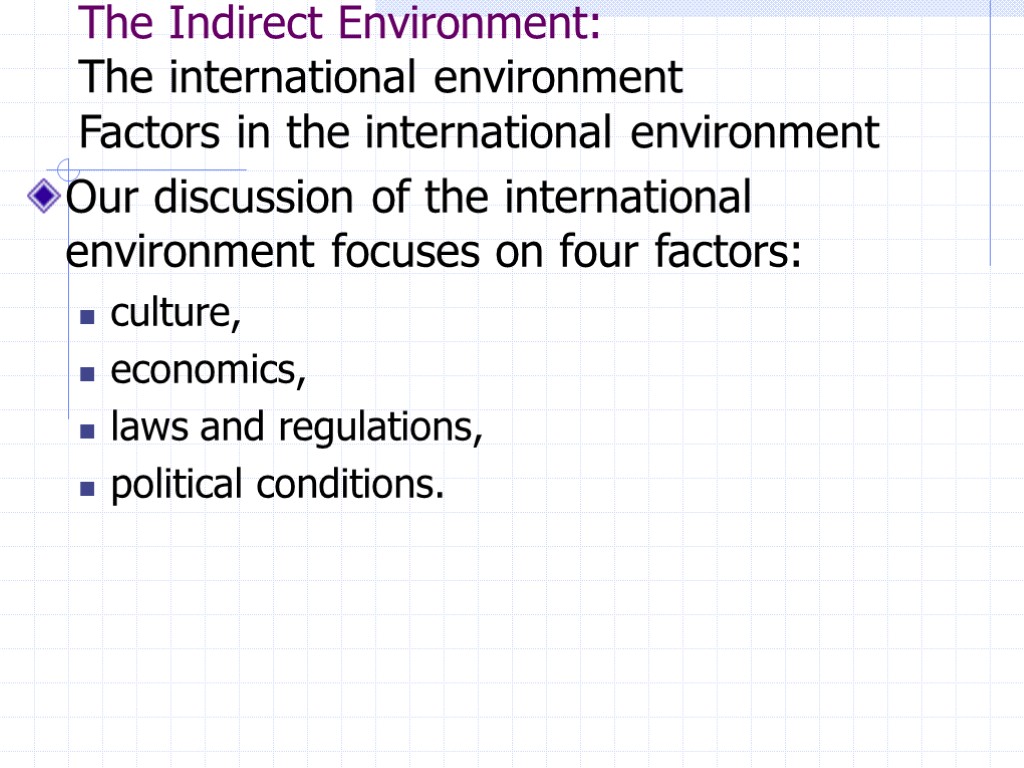
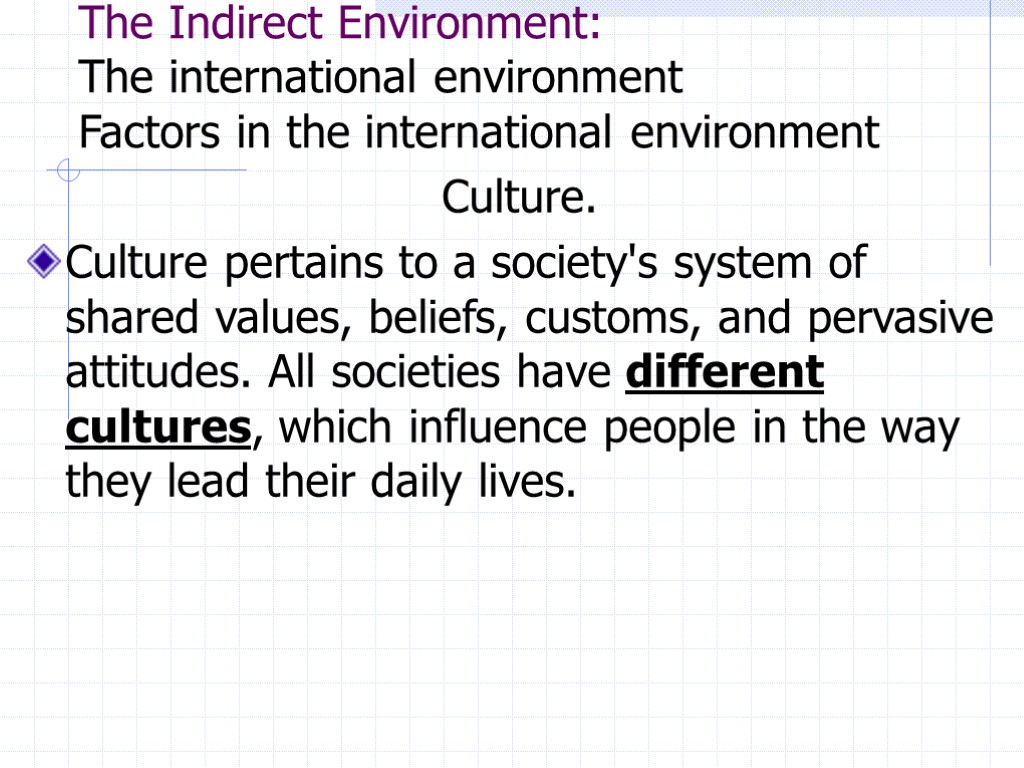
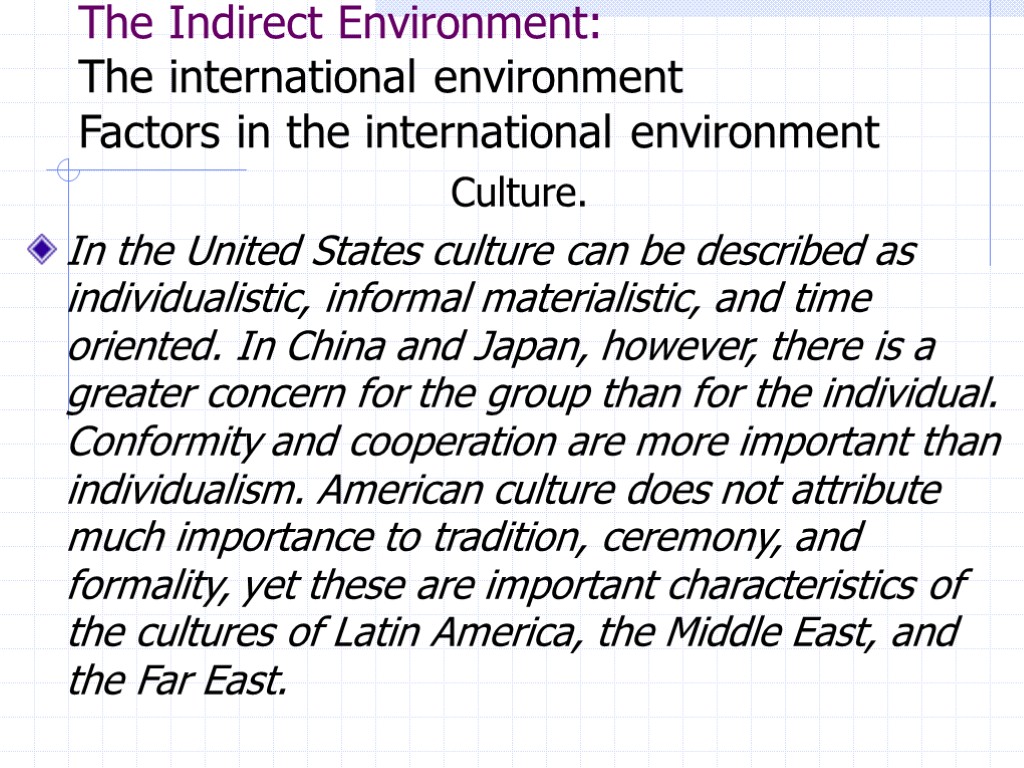
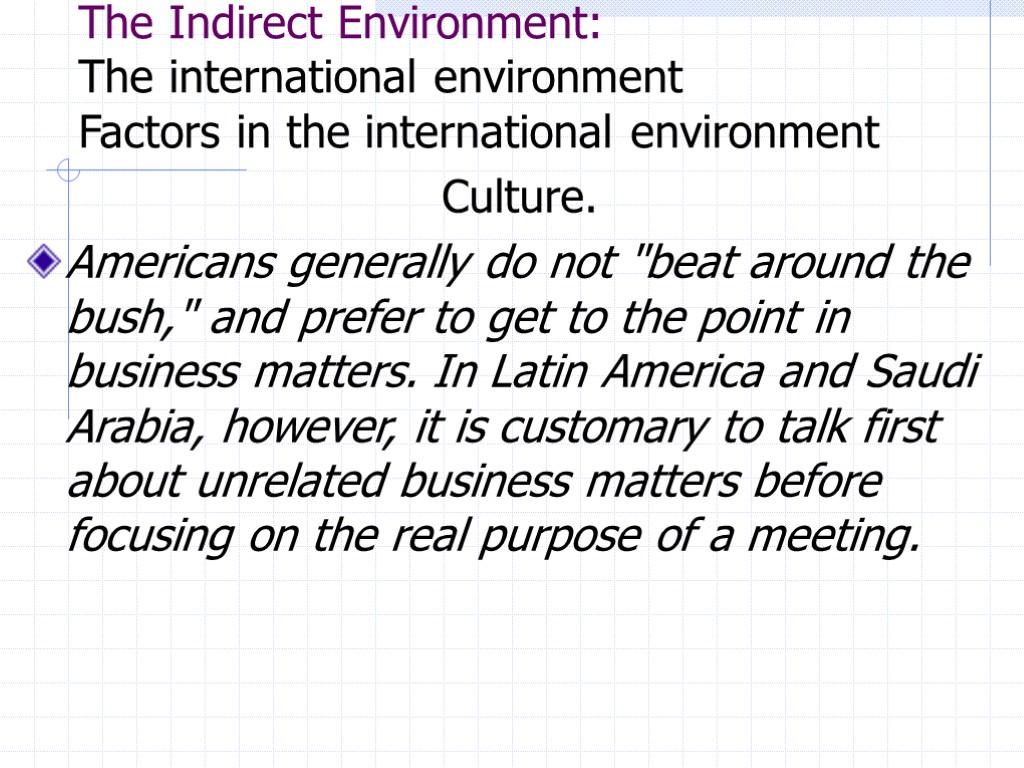
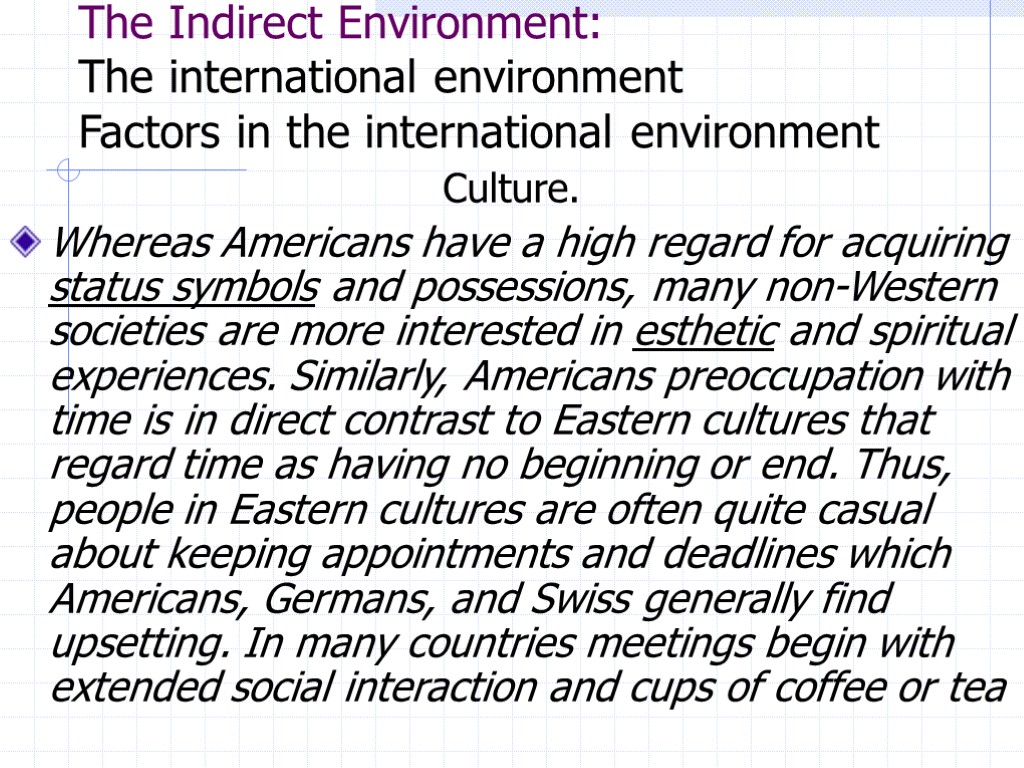

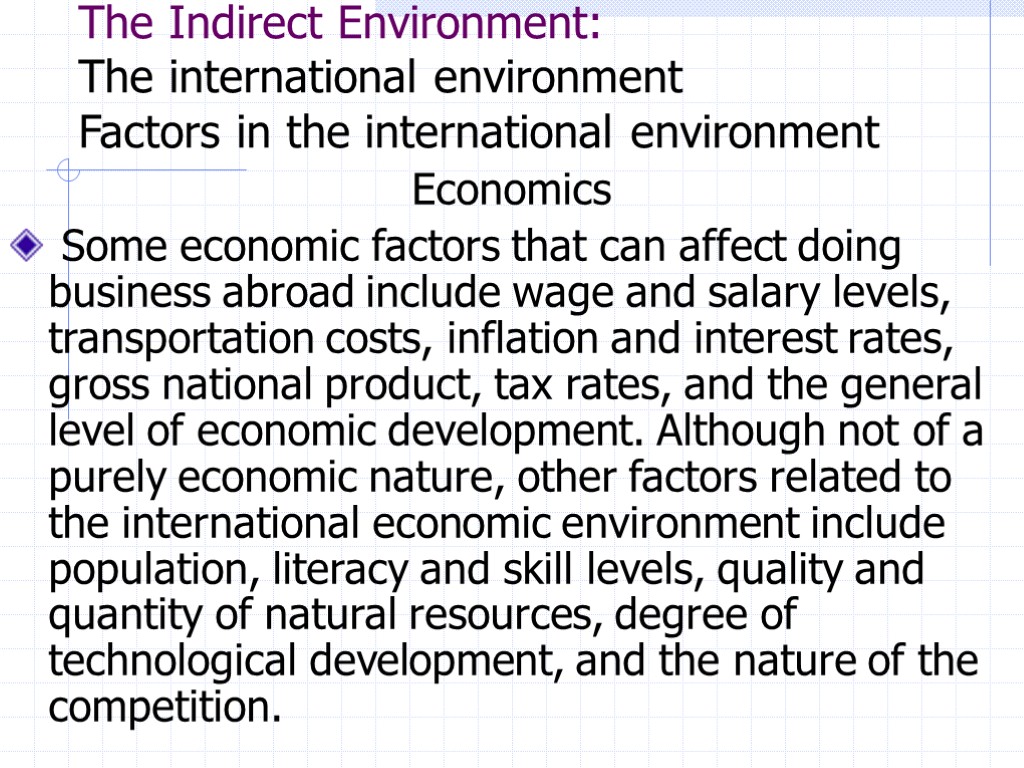
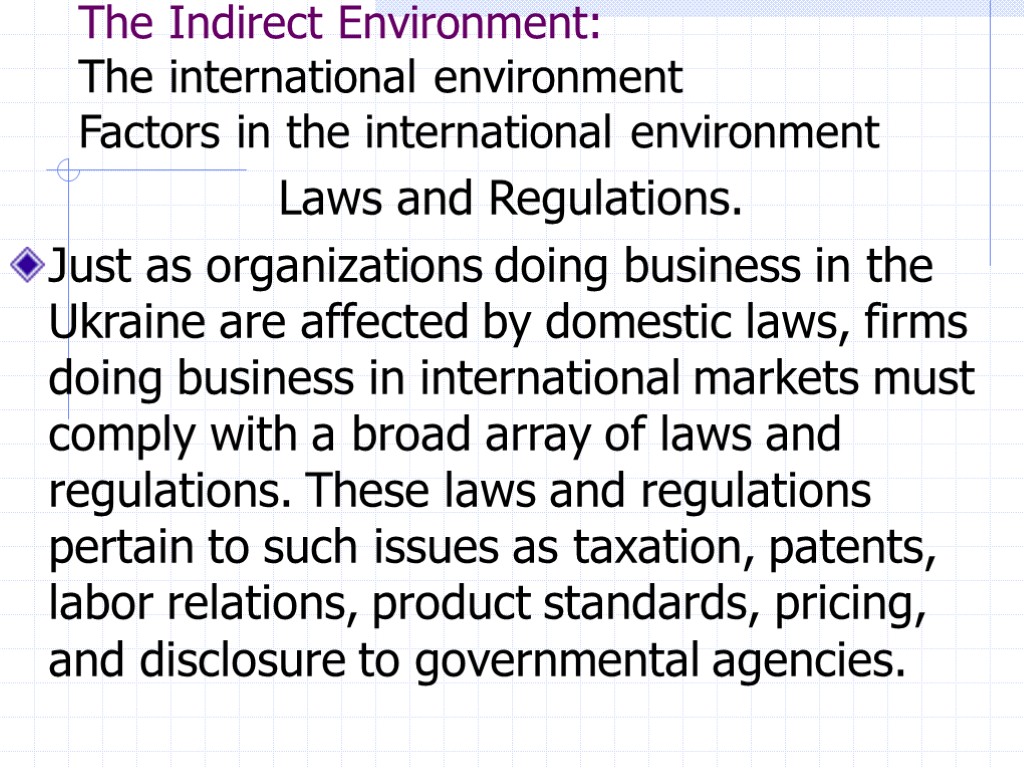
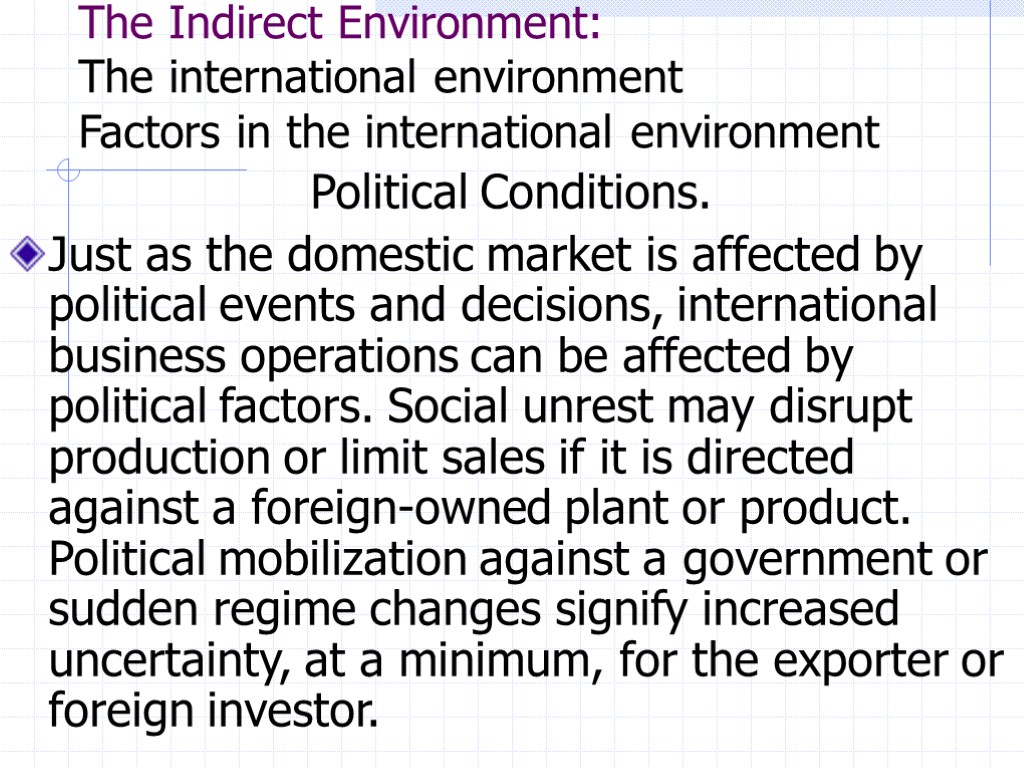

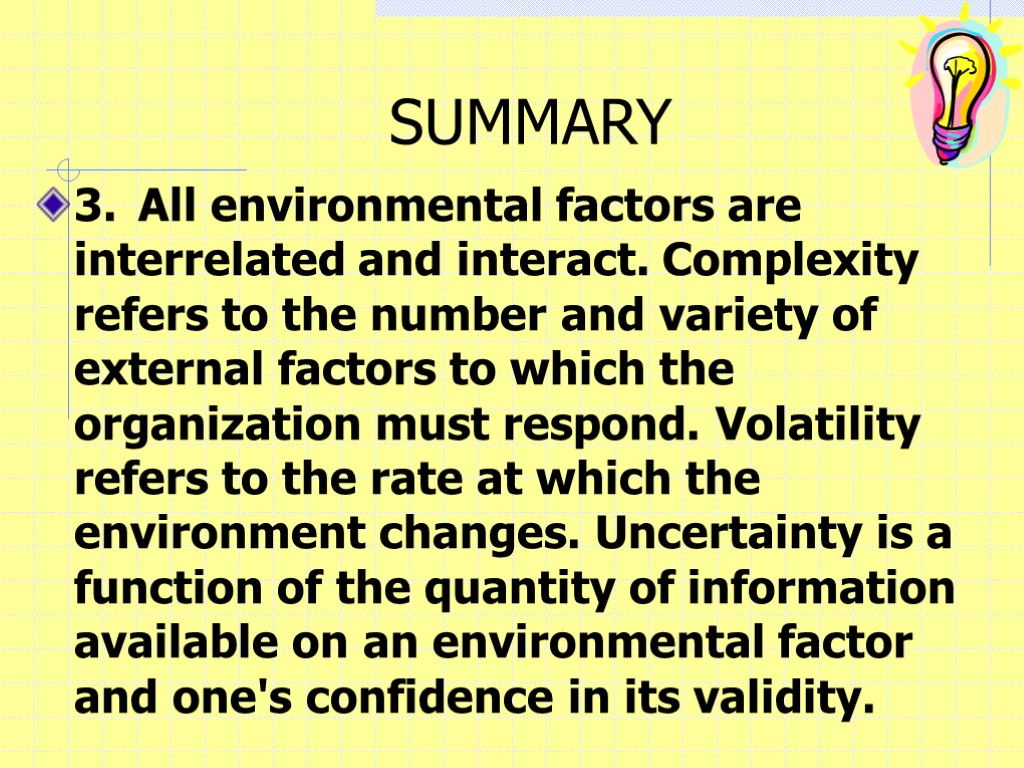
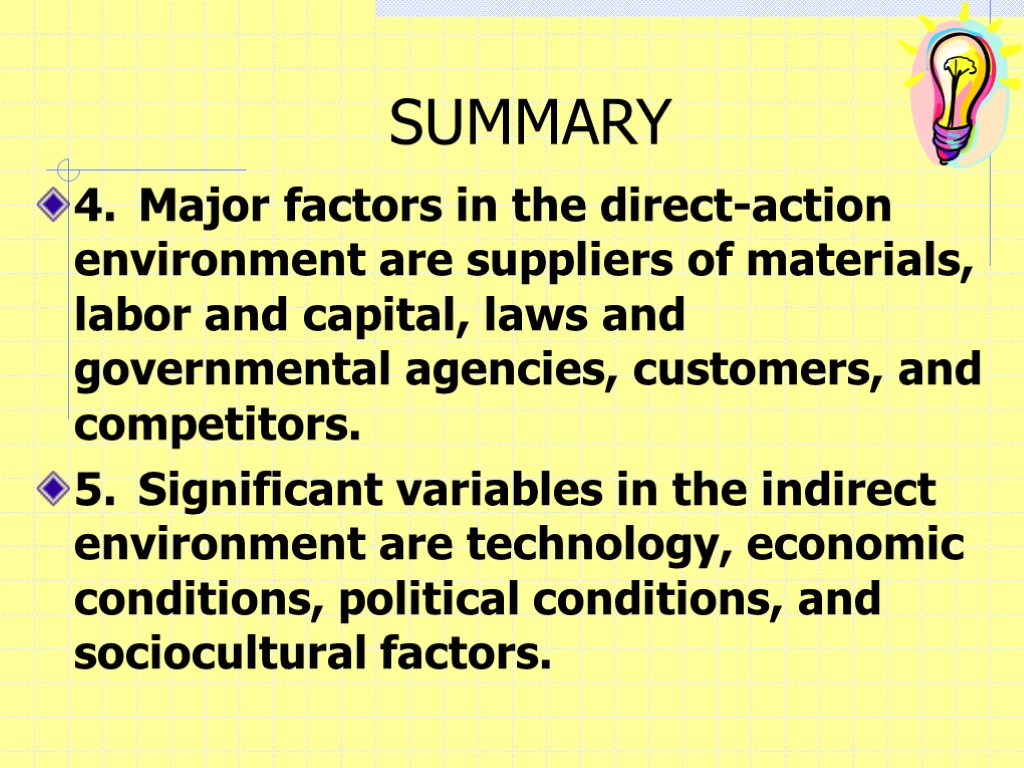
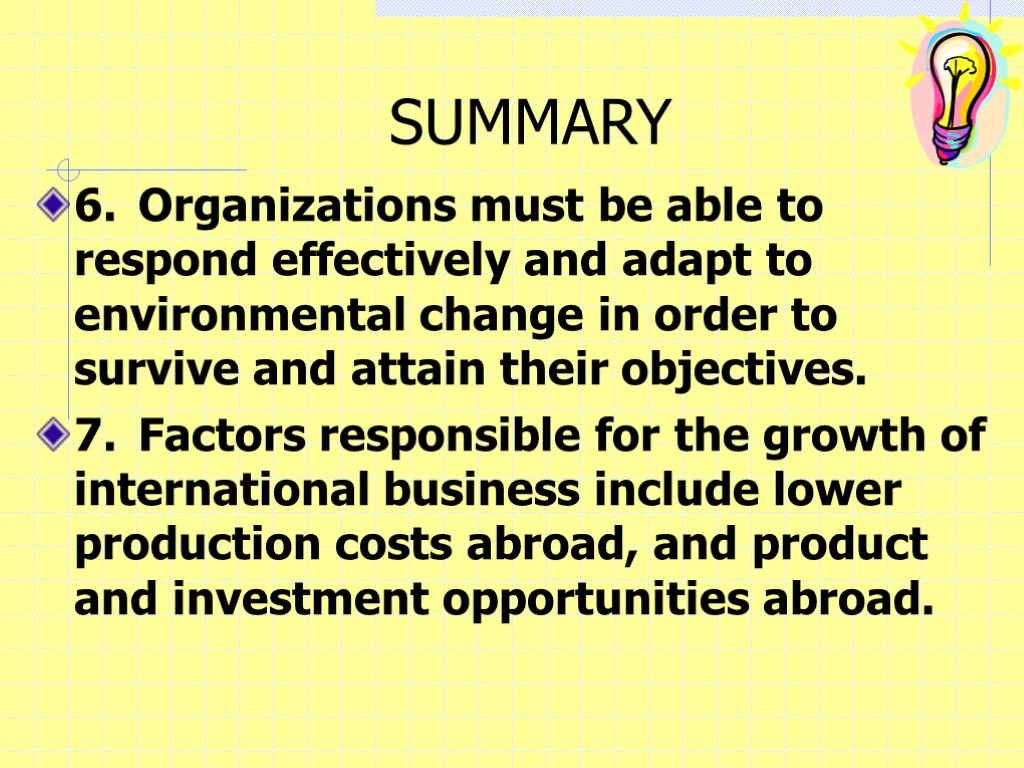
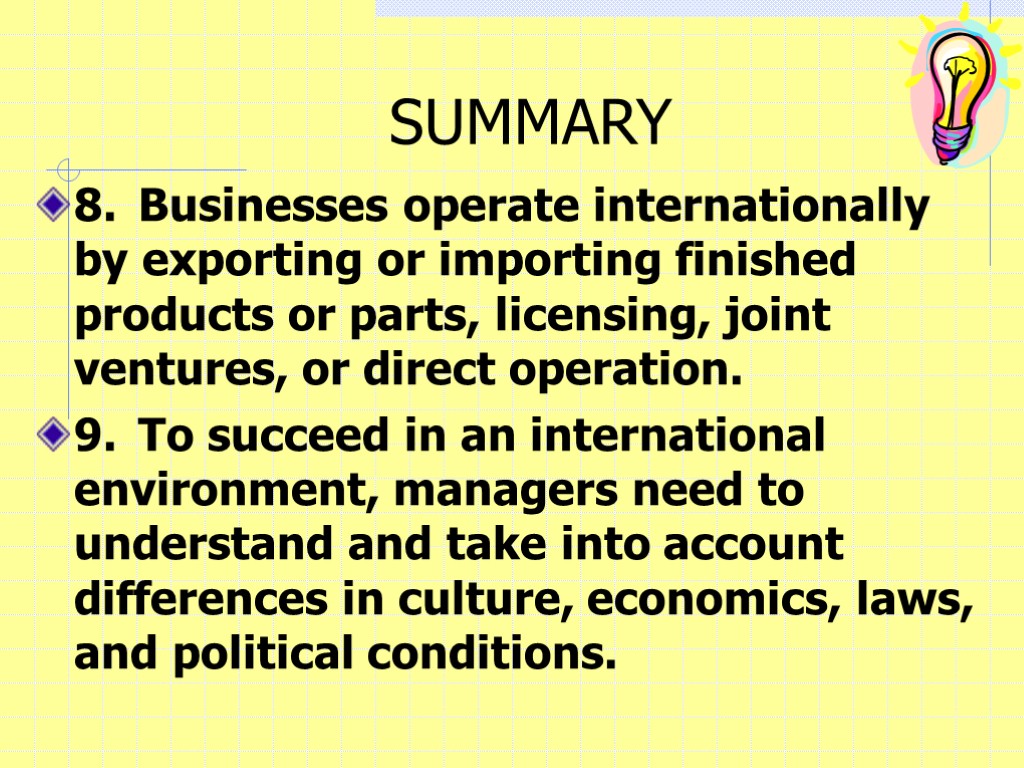
lec4=external_environment.ppt
- Количество слайдов: 82
 External Environment
External Environment
 External Environment Thus far our discussion of the major variables affecting organizational success centered on factors within the organization. It seems obvious and logical that the primary concern of management should be its own organization. However, forces outside of the organization, in the global external environment, have a determining effect on the success of the organization. Understanding these external variables is essential in performing management functions effectively in today's complex world.
External Environment Thus far our discussion of the major variables affecting organizational success centered on factors within the organization. It seems obvious and logical that the primary concern of management should be its own organization. However, forces outside of the organization, in the global external environment, have a determining effect on the success of the organization. Understanding these external variables is essential in performing management functions effectively in today's complex world.
 External Environment Internal factors were the focal point of the schools of management. Each school directed its attention primarily to those aspects it felt management had to affect for success to occur. The scientific management school, for example, concentrated primarily on tasks and technology. Administrative management focused on creating a structure that would facilitate attaining organizational objectives. The human relations school concentrated on people.
External Environment Internal factors were the focal point of the schools of management. Each school directed its attention primarily to those aspects it felt management had to affect for success to occur. The scientific management school, for example, concentrated primarily on tasks and technology. Administrative management focused on creating a structure that would facilitate attaining organizational objectives. The human relations school concentrated on people.
 External Environment Writers of these early schools paid little attention to factors outside of the organization. While viewed as a major shortcoming today, it was not seen as one at the time. Each school's contributions, in fact, proved effective in increasing an organization's ability to attain objectives. Thus these schools were, in a sense, correct in concentrating on internal issues because they were of greater relative importance to an organization's effectiveness and survival. As we will see, however, contemporary organizations must adapt to changes in the external environment and make appropriate modifications internally.
External Environment Writers of these early schools paid little attention to factors outside of the organization. While viewed as a major shortcoming today, it was not seen as one at the time. Each school's contributions, in fact, proved effective in increasing an organization's ability to attain objectives. Thus these schools were, in a sense, correct in concentrating on internal issues because they were of greater relative importance to an organization's effectiveness and survival. As we will see, however, contemporary organizations must adapt to changes in the external environment and make appropriate modifications internally.
 Importance of the Environment The importance of the environment and the need to consider forces external to the organization were first incorporated into management thought during the late 1950s. It was one of the major contributions of the systems approach to management, which stressed the need for managers to view their organization as an entity of interrelated parts intertwined with the outside world. The contingency approach extended systems theory by developing the concept that the most appropriate technique in a particular situation is determined by specific internal and external factors that characterize and affect the organization.
Importance of the Environment The importance of the environment and the need to consider forces external to the organization were first incorporated into management thought during the late 1950s. It was one of the major contributions of the systems approach to management, which stressed the need for managers to view their organization as an entity of interrelated parts intertwined with the outside world. The contingency approach extended systems theory by developing the concept that the most appropriate technique in a particular situation is determined by specific internal and external factors that characterize and affect the organization.
 Importance of the Environment The systems and contingency views arose in response to changes that were affecting organizational success to an ever greater degree. Today changes in the outside world have made the need to consider the environment more important than ever. The external environment of an organization is a subject of increasing challenge for today's managers. In fact, the managers of societies' major organizations—business, education, government—have been forced by recent events to place an increasing focus on a rapidly changing environment and its effect on the internal organization.
Importance of the Environment The systems and contingency views arose in response to changes that were affecting organizational success to an ever greater degree. Today changes in the outside world have made the need to consider the environment more important than ever. The external environment of an organization is a subject of increasing challenge for today's managers. In fact, the managers of societies' major organizations—business, education, government—have been forced by recent events to place an increasing focus on a rapidly changing environment and its effect on the internal organization.
 Importance of the Environment Even if change were not so significant, management still would have to consider the environment because, as an open system, an organization is dependent on the outside world for supplies, energy, labor, and customers. Because they affect the organization's survival, management must be able to identify the important factors in its environment that will have a major impact on the organization. Moreover, managers must develop appropriate responses to these inputs.
Importance of the Environment Even if change were not so significant, management still would have to consider the environment because, as an open system, an organization is dependent on the outside world for supplies, energy, labor, and customers. Because they affect the organization's survival, management must be able to identify the important factors in its environment that will have a major impact on the organization. Moreover, managers must develop appropriate responses to these inputs.
 Importance of the Environment Organizations are similar to biological organisms. According to Charles Darwin's theory of evolution, the species that have survived have done so because they were able to evolve and adapt to changes in their environment. Organizations, too, must adapt to changes in their environment in order to survive and be effective. Thus, management must follow a policy of organizational darwinism to ensure that in a world of rapid change where only the fit survive, their organization will not be among those that become extinct.
Importance of the Environment Organizations are similar to biological organisms. According to Charles Darwin's theory of evolution, the species that have survived have done so because they were able to evolve and adapt to changes in their environment. Organizations, too, must adapt to changes in their environment in order to survive and be effective. Thus, management must follow a policy of organizational darwinism to ensure that in a world of rapid change where only the fit survive, their organization will not be among those that become extinct.
 Defining the Environment The first problem facing the manager wishing to adopt an open-systems perspective is defining the environment. The world, after all, is large, and it would be hopelessly confusing to attempt to consider every factor in it. Management clearly must limit its consideration of the environment to those aspects of major importance to the success of their organization. Thus, an organization's external environment consists of those things outside an organization such as customers, competitors, government units, suppliers, financial firms, and labor pools that are relevant to an organization's operations.
Defining the Environment The first problem facing the manager wishing to adopt an open-systems perspective is defining the environment. The world, after all, is large, and it would be hopelessly confusing to attempt to consider every factor in it. Management clearly must limit its consideration of the environment to those aspects of major importance to the success of their organization. Thus, an organization's external environment consists of those things outside an organization such as customers, competitors, government units, suppliers, financial firms, and labor pools that are relevant to an organization's operations.
 Direct-Action Versus Indirect Environment One way of defining the environment and making its influence on the organization easier to comprehend is to divide environmental forces into two major categories. We will consider forces external to the organization as either direct-action or indirect.
Direct-Action Versus Indirect Environment One way of defining the environment and making its influence on the organization easier to comprehend is to divide environmental forces into two major categories. We will consider forces external to the organization as either direct-action or indirect.
 Direct-Action Versus Indirect Environment The direct-action environment consists of those factors that directly affect and are affected by the organization's operations. These factors would include suppliers, labor, laws and governmental regulatory agencies, customers, and competitors. The indirect environment is those factors that may not have an immediate, direct effect on operations but nevertheless influence them. These include such factors as general economic conditions, technology, sociocultural and political developments, interest groups, and the influence of events in foreign countries.
Direct-Action Versus Indirect Environment The direct-action environment consists of those factors that directly affect and are affected by the organization's operations. These factors would include suppliers, labor, laws and governmental regulatory agencies, customers, and competitors. The indirect environment is those factors that may not have an immediate, direct effect on operations but nevertheless influence them. These include such factors as general economic conditions, technology, sociocultural and political developments, interest groups, and the influence of events in foreign countries.
 Characteristics of the Environment Many environmental factors can affect an organization. In the past, managers concentrated attention on their economic and technical environments. In recent years, however, changes in human attitudes, social values, political forces, and legal liabilities have forced managers to broaden the scope of the environmental forces they consider.
Characteristics of the Environment Many environmental factors can affect an organization. In the past, managers concentrated attention on their economic and technical environments. In recent years, however, changes in human attitudes, social values, political forces, and legal liabilities have forced managers to broaden the scope of the environmental forces they consider.
 Characteristics of the Environment: Environmental interrelatedness Environmental interrelatedness is the degree to which changes in one factor affect other factors. Just as a change in one of the internal variables may affect the others, a change in one external factor can cause changes in others.
Characteristics of the Environment: Environmental interrelatedness Environmental interrelatedness is the degree to which changes in one factor affect other factors. Just as a change in one of the internal variables may affect the others, a change in one external factor can cause changes in others.
 Characteristics of the Environment: Environmental interrelatedness For example, in the 1970s decreased supplies of oil, primarily due to changes in the political structure and aims of foreign countries, had a strong effect on general economic conditions in the United States. Higher prices for petroleum products caused a general increase in prices of almost all products. They also catalyzed a wave of governmental action, such as attempts to regulate temperatures in public places, fuel allocation, specification of fuel efficiency standards, windfall-profits taxes on oil companies, and initiation of a massive federal project to overcome dependence on foreign energy.
Characteristics of the Environment: Environmental interrelatedness For example, in the 1970s decreased supplies of oil, primarily due to changes in the political structure and aims of foreign countries, had a strong effect on general economic conditions in the United States. Higher prices for petroleum products caused a general increase in prices of almost all products. They also catalyzed a wave of governmental action, such as attempts to regulate temperatures in public places, fuel allocation, specification of fuel efficiency standards, windfall-profits taxes on oil companies, and initiation of a massive federal project to overcome dependence on foreign energy.
 Characteristics of the Environment: Environmental interrelatedness Prior to the sharp drop in the price of gasoline the direct environment of many organizations was also affected because unions demanded more pay to compensate for inflated prices. Certain firms, such as those manufacturing recreational vehicles and large automobiles, and automobile-dependent tourism suffered a loss of customers. In some cases the effect was beneficial. Business improved for some firms supplying insulation, developing synthetic fuels, and producing solar energy devices and electric cars. However, competition in these fields increased as more firms sought a share of this increased business.
Characteristics of the Environment: Environmental interrelatedness Prior to the sharp drop in the price of gasoline the direct environment of many organizations was also affected because unions demanded more pay to compensate for inflated prices. Certain firms, such as those manufacturing recreational vehicles and large automobiles, and automobile-dependent tourism suffered a loss of customers. In some cases the effect was beneficial. Business improved for some firms supplying insulation, developing synthetic fuels, and producing solar energy devices and electric cars. However, competition in these fields increased as more firms sought a share of this increased business.
 Characteristics of the Environment: Environmental interrelatedness The effect of the interrelatedness of the various environmental factors has been to create a turbulent environment for contemporary organizations. It no longer is feasible for managers to consider environmental factors independently. Managers must realize that the factors are interrelated and changing.
Characteristics of the Environment: Environmental interrelatedness The effect of the interrelatedness of the various environmental factors has been to create a turbulent environment for contemporary organizations. It no longer is feasible for managers to consider environmental factors independently. Managers must realize that the factors are interrelated and changing.
 Characteristics of the Environment: Environmental Complexity Environmental complexity refers to the number of external factors to which the organization must respond and also to the degree of variety within each factor.
Characteristics of the Environment: Environmental Complexity Environmental complexity refers to the number of external factors to which the organization must respond and also to the degree of variety within each factor.
 Characteristics of the Environment: Environmental Complexity With respect to the number of environmental factors to which an organization must respond, an organization that is subject to much government regulation, frequent negotiations with unions, several interest groups, many competitors, and rapid technological development would be considered to have a more complex environment than an organization concerned primarily with a few suppliers, a few competitors, no unions, and a field in which technological development is slow.
Characteristics of the Environment: Environmental Complexity With respect to the number of environmental factors to which an organization must respond, an organization that is subject to much government regulation, frequent negotiations with unions, several interest groups, many competitors, and rapid technological development would be considered to have a more complex environment than an organization concerned primarily with a few suppliers, a few competitors, no unions, and a field in which technological development is slow.
 Characteristics of the Environment: Environmental Volatility Environmental volatility is the rate at which an organization's environment changes. Many writers have stated that the environment of contemporary organizations is changing at an increasing rate.
Characteristics of the Environment: Environmental Volatility Environmental volatility is the rate at which an organization's environment changes. Many writers have stated that the environment of contemporary organizations is changing at an increasing rate.
 Characteristics of the Environment: Environmental Volatility However, although the overall rate of change is increasing, environmental volatility is greater for some organizations than for others. For example, two researchers found that the rate of change in the technological and competitive environments was greater in the drug, chemicals, and electronics industries than in the machinery, auto parts, and confectionary industries. Industries undergoing rapid change include aerospace, computers, telecommunications, and biotechnology. Industries undergoing less relative change include packaging, furniture, and canned foods.
Characteristics of the Environment: Environmental Volatility However, although the overall rate of change is increasing, environmental volatility is greater for some organizations than for others. For example, two researchers found that the rate of change in the technological and competitive environments was greater in the drug, chemicals, and electronics industries than in the machinery, auto parts, and confectionary industries. Industries undergoing rapid change include aerospace, computers, telecommunications, and biotechnology. Industries undergoing less relative change include packaging, furniture, and canned foods.
 Characteristics of the Environment: Environmental Volatility Furthermore, environmental volatility can be greater for some subunits of an organization than for others. In many firms, for example, the research and development department, because it must keep track of newly developing technological applications, faces high volatility. The production department, on the other hand, may deal with a relatively slowly changing environment characterized by a steady flow of raw materials and labor.
Characteristics of the Environment: Environmental Volatility Furthermore, environmental volatility can be greater for some subunits of an organization than for others. In many firms, for example, the research and development department, because it must keep track of newly developing technological applications, faces high volatility. The production department, on the other hand, may deal with a relatively slowly changing environment characterized by a steady flow of raw materials and labor.
 Characteristics of the Environment: Environmental Volatility Alternatively, having production facilities in several countries or obtaining resource inputs from overseas could subject the production process to volatility. As with complexity, organizations or subunits in a highly volatile environment must obtain more diverse information in order to make effective decisions concerning their internal variables. This makes decision making more difficult.
Characteristics of the Environment: Environmental Volatility Alternatively, having production facilities in several countries or obtaining resource inputs from overseas could subject the production process to volatility. As with complexity, organizations or subunits in a highly volatile environment must obtain more diverse information in order to make effective decisions concerning their internal variables. This makes decision making more difficult.
 Characteristics of the Environment: Environmental Uncertainty Environmental uncertainty is a function of the amount of information one has about a given factor and one's confidence in that information. If little information is available or if one has little confidence in its accuracy, the environment is more uncertain than if adequate information is available and there is good reason to consider it highly accurate. As business becomes more global, though more information is available, confidence in its accuracy goes down. Dependence on foreign experts or analyses written in other languages adds to the uncertainty. The more uncertain the environment, the more difficult it is to make effective decisions.
Characteristics of the Environment: Environmental Uncertainty Environmental uncertainty is a function of the amount of information one has about a given factor and one's confidence in that information. If little information is available or if one has little confidence in its accuracy, the environment is more uncertain than if adequate information is available and there is good reason to consider it highly accurate. As business becomes more global, though more information is available, confidence in its accuracy goes down. Dependence on foreign experts or analyses written in other languages adds to the uncertainty. The more uncertain the environment, the more difficult it is to make effective decisions.
 Characteristics of the Environment 1. Interrelatedness: degree to which changes in one factor affect other factors 2. Complexity: number and variety of factors that significantly affect the organization 3. Volatility: relative rate of change 4. Uncertainty: relative amount of information available about the environment and one's confidence in its accuracy
Characteristics of the Environment 1. Interrelatedness: degree to which changes in one factor affect other factors 2. Complexity: number and variety of factors that significantly affect the organization 3. Volatility: relative rate of change 4. Uncertainty: relative amount of information available about the environment and one's confidence in its accuracy
 The Direct-Action Environment
The Direct-Action Environment
 The Direct-Action Environment When considering the effect of the environment on an organization, it is important to understand that the characteristics of the environment are distinct from but related to the factors in the environment. The characteristics of interrelatedness, complexity, volatility, and uncertainty are descriptive of both indirect and direct-action factors. This relationship will become more apparent as we discuss the major factors in the direct-action environment: suppliers, laws and governmental agencies, customers, and competitors.
The Direct-Action Environment When considering the effect of the environment on an organization, it is important to understand that the characteristics of the environment are distinct from but related to the factors in the environment. The characteristics of interrelatedness, complexity, volatility, and uncertainty are descriptive of both indirect and direct-action factors. This relationship will become more apparent as we discuss the major factors in the direct-action environment: suppliers, laws and governmental agencies, customers, and competitors.
 The Direct-Action Environment: Suppliers From a systems perspective an organization is a vehicle for transforming inputs into outputs. The major types of inputs are materials, equipment, energy, capital, and labor. The relationship between the organization and the network of suppliers from which these inputs are obtained is one of the clearest examples of forces in the environment directly influencing the operation and success of an organization.
The Direct-Action Environment: Suppliers From a systems perspective an organization is a vehicle for transforming inputs into outputs. The major types of inputs are materials, equipment, energy, capital, and labor. The relationship between the organization and the network of suppliers from which these inputs are obtained is one of the clearest examples of forces in the environment directly influencing the operation and success of an organization.
 The Direct-Action Environment: Suppliers Obtaining resources (now often called sourcing) from overseas suppliers could provide advantages in price, quality, or quantity, but might add volatility factors such as currency fluctuations or political disruptions.
The Direct-Action Environment: Suppliers Obtaining resources (now often called sourcing) from overseas suppliers could provide advantages in price, quality, or quantity, but might add volatility factors such as currency fluctuations or political disruptions.
 The Direct-Action Environment: Suppliers In some cases all organizations in a given area deal with the same supplier or at least a comparable one. Therefore, they all are affected equally by the supplier's actions. Energy is a good example. All organizations obtain electricity at rates that are determined by governmental agencies (an example of interrelated external variables) and rarely can they choose an alternative supplier, even if they believe the service is inadequate or too expensive
The Direct-Action Environment: Suppliers In some cases all organizations in a given area deal with the same supplier or at least a comparable one. Therefore, they all are affected equally by the supplier's actions. Energy is a good example. All organizations obtain electricity at rates that are determined by governmental agencies (an example of interrelated external variables) and rarely can they choose an alternative supplier, even if they believe the service is inadequate or too expensive
 The Direct-Action Environment: Suppliers (Materials). Some organizations are highly dependent on a continuous inflow of materials. Examples are manufacturing firms, distributors, and retail stores. Failure to obtain supplies as needed can cause severe problems for such organizations. Think about what it would cost General Motors to run out of a part that has to be installed at a particular point on the assembly line. Similarly, if a retail store runs out of stock on a popular item, its customers are likely to go to a competitor
The Direct-Action Environment: Suppliers (Materials). Some organizations are highly dependent on a continuous inflow of materials. Examples are manufacturing firms, distributors, and retail stores. Failure to obtain supplies as needed can cause severe problems for such organizations. Think about what it would cost General Motors to run out of a part that has to be installed at a particular point on the assembly line. Similarly, if a retail store runs out of stock on a popular item, its customers are likely to go to a competitor
 The Direct-Action Environment: Suppliers: Capital As with materials, there are suppliers of capital, which the firm needs to grow and flourish. There are several potential suppliers of capital: banks, federal agency loan programs, stockholders, and individual investors. In general, the more successful an organization, the better able it is to negotiate attractive terms with these suppliers and obtain the amount of capital it desires. Small businesses, and in particular new ventures, experience great difficulty in obtaining capital today.
The Direct-Action Environment: Suppliers: Capital As with materials, there are suppliers of capital, which the firm needs to grow and flourish. There are several potential suppliers of capital: banks, federal agency loan programs, stockholders, and individual investors. In general, the more successful an organization, the better able it is to negotiate attractive terms with these suppliers and obtain the amount of capital it desires. Small businesses, and in particular new ventures, experience great difficulty in obtaining capital today.
 The Direct-Action Environment: Suppliers: Labor An adequate supply of people with the ability and skills required to perform and manage the tasks involved in attaining objectives is vital to an organization's effectiveness. Without people able to use them effectively, sophisticated technology, capital, and materials are of little value. Most organizations attempt to cope with labor supply problems through training and development of current personnel.
The Direct-Action Environment: Suppliers: Labor An adequate supply of people with the ability and skills required to perform and manage the tasks involved in attaining objectives is vital to an organization's effectiveness. Without people able to use them effectively, sophisticated technology, capital, and materials are of little value. Most organizations attempt to cope with labor supply problems through training and development of current personnel.
 The Direct-Action Environment: Laws and Governmental Agencies Many laws and governmental agencies affect organizations. In a basically private-enterprise economy such as ours, the interaction between buyers and sellers of every input and output is subject to many legal restrictions. Every organization has a specific legal status, such as sole proprietorship, partnership, corporation, or nonprofit corporation, that establishes how it can conduct business and how it will be taxed.
The Direct-Action Environment: Laws and Governmental Agencies Many laws and governmental agencies affect organizations. In a basically private-enterprise economy such as ours, the interaction between buyers and sellers of every input and output is subject to many legal restrictions. Every organization has a specific legal status, such as sole proprietorship, partnership, corporation, or nonprofit corporation, that establishes how it can conduct business and how it will be taxed.
 The Direct-Action Environment: Customers There are many who agree with popular management writer Peter E Drucker's view that the only valid business purpose is to create a customer. By this Mr. Drucker means that an organization's survival and reason for existence depend on its ability to identify a customer for its output and meet its needs.
The Direct-Action Environment: Customers There are many who agree with popular management writer Peter E Drucker's view that the only valid business purpose is to create a customer. By this Mr. Drucker means that an organization's survival and reason for existence depend on its ability to identify a customer for its output and meet its needs.
 The Direct-Action Environment: Customers An organization's customers, by deciding which goods and services are desirable and at what price, determine almost everything related to its output. The need to meet customer requirements thereby affects interactions with suppliers of both material and labor.
The Direct-Action Environment: Customers An organization's customers, by deciding which goods and services are desirable and at what price, determine almost everything related to its output. The need to meet customer requirements thereby affects interactions with suppliers of both material and labor.
 The Direct-Action Environment: Competitors Competitors are an external factor whose effect is never disputed. The management of every business is acutely aware that unless it meets the needs of customers as effectively as do competitors, the firm cannot survive long. In many cases it is not customers but competitors who determine what sort of output can be sold and what price can be charged.
The Direct-Action Environment: Competitors Competitors are an external factor whose effect is never disputed. The management of every business is acutely aware that unless it meets the needs of customers as effectively as do competitors, the firm cannot survive long. In many cases it is not customers but competitors who determine what sort of output can be sold and what price can be charged.
 The Direct-Action Environment: Competitors In 1955 Harley-Davidson held nearly 70 percent of the U.S. motorcycle market. By 1970 the figure was only 5 percent and by 1983, 3.7 percent. Honda, Yamaha, Suzuki, and Kawasaki were the primary players in this new game. What Harley-Davidson had treated as a mature industry, the new players transformed with redesigned products and highly effective marketing that created new images and new markets.
The Direct-Action Environment: Competitors In 1955 Harley-Davidson held nearly 70 percent of the U.S. motorcycle market. By 1970 the figure was only 5 percent and by 1983, 3.7 percent. Honda, Yamaha, Suzuki, and Kawasaki were the primary players in this new game. What Harley-Davidson had treated as a mature industry, the new players transformed with redesigned products and highly effective marketing that created new images and new markets.
 The Direct-Action Environment: Competitors It is important to realize that customers are not the only area of competition among organizations. Organizations also often compete for labor, materials, capital, and the right to use certain technical innovations. Thus, responses to competition affect such internal factors as working conditions, pay, and how management deals with subordinates.
The Direct-Action Environment: Competitors It is important to realize that customers are not the only area of competition among organizations. Organizations also often compete for labor, materials, capital, and the right to use certain technical innovations. Thus, responses to competition affect such internal factors as working conditions, pay, and how management deals with subordinates.
 The Direct-Action Environment: Competitors In today's complex organizational society the relationship with competitors sometimes takes peculiar twists. In 1979, for example, General Motors agreed to loan several hundred million dollars to its traditional rival Chrysler Corporation. GM probably wanted to help Chrysler to prevent foreign auto manufacturers from making further gains in the American market. If Chrysler had collapsed, a foreign firm might have been able to pick up its large dealer network and thereby expand quickly.
The Direct-Action Environment: Competitors In today's complex organizational society the relationship with competitors sometimes takes peculiar twists. In 1979, for example, General Motors agreed to loan several hundred million dollars to its traditional rival Chrysler Corporation. GM probably wanted to help Chrysler to prevent foreign auto manufacturers from making further gains in the American market. If Chrysler had collapsed, a foreign firm might have been able to pick up its large dealer network and thereby expand quickly.
 The Indirect Environment
The Indirect Environment
 The Indirect Environment Factors in the indirect environment usually do not have as marked an effect on the organization's operations as those in the direct-action environment. However, management must take them into account. The indirect environment is usually more complex and uncertain than the direct. Management is often compelled to make assumptions about it based on incomplete information in order to predict what the impact on the organization will be.
The Indirect Environment Factors in the indirect environment usually do not have as marked an effect on the organization's operations as those in the direct-action environment. However, management must take them into account. The indirect environment is usually more complex and uncertain than the direct. Management is often compelled to make assumptions about it based on incomplete information in order to predict what the impact on the organization will be.
 The Indirect Environment: Technology Technology is both an internal variable and an external factor of major importance. New technological developments affect the efficiency with which products can be manufactured and sold, when a product will become obsolete, how information can be gathered, stored, and distributed by an organization, and what customers expect of organizations in the way of services and new products.
The Indirect Environment: Technology Technology is both an internal variable and an external factor of major importance. New technological developments affect the efficiency with which products can be manufactured and sold, when a product will become obsolete, how information can be gathered, stored, and distributed by an organization, and what customers expect of organizations in the way of services and new products.
 The Indirect Environment: Technology Several writers have described the rapid rate at which technology has changed in recent decades and contend this trend will continue. One reason for this rapid change is that more scientists are living today than ever lived before. Some recent major technological developments that have profoundly affected organizations and society are the computer, laser, microwave, integrated circuits, semiconductors, robotics, satellite communication, nuclear power, synthetic fuels and foods, and gene splicing.
The Indirect Environment: Technology Several writers have described the rapid rate at which technology has changed in recent decades and contend this trend will continue. One reason for this rapid change is that more scientists are living today than ever lived before. Some recent major technological developments that have profoundly affected organizations and society are the computer, laser, microwave, integrated circuits, semiconductors, robotics, satellite communication, nuclear power, synthetic fuels and foods, and gene splicing.
 The Indirect Environment: Technology Clearly, an organization that deals directly with high technology must be able to respond quickly to new developments and create innovations of its own. However, today all organizations need to keep abreast of at least those developments affecting the efficiency of operations in order to remain competitive.
The Indirect Environment: Technology Clearly, an organization that deals directly with high technology must be able to respond quickly to new developments and create innovations of its own. However, today all organizations need to keep abreast of at least those developments affecting the efficiency of operations in order to remain competitive.
 The Indirect Environment: Economic Conditions Management also must assess how changes in general economic conditions will affect the organization's operations. Economic conditions throughout the world affect the cost of all inputs and the ability of customers to buy certain goods and services
The Indirect Environment: Economic Conditions Management also must assess how changes in general economic conditions will affect the organization's operations. Economic conditions throughout the world affect the cost of all inputs and the ability of customers to buy certain goods and services
 The Indirect Environment: Economic Conditions If inflation is predicted, for example, management may find it desirable to increase inventories of supplies and to negotiate fixed-cost labor contracts to hold down costs in the future. It may also find it desirable to borrow because when repayment is due the money will be worth less, offsetting the cost of interest. Similarly, if a recession is predicted, the organization may find it necessary to reduce its inventory of products because they may not be saleable, to reduce the size of its labor force, or to postpone plans for expansion
The Indirect Environment: Economic Conditions If inflation is predicted, for example, management may find it desirable to increase inventories of supplies and to negotiate fixed-cost labor contracts to hold down costs in the future. It may also find it desirable to borrow because when repayment is due the money will be worth less, offsetting the cost of interest. Similarly, if a recession is predicted, the organization may find it necessary to reduce its inventory of products because they may not be saleable, to reduce the size of its labor force, or to postpone plans for expansion
 The Indirect Environment: Economic Conditions Economic conditions can strongly affect an organization's ability to obtain capital. This is largely because the federal government often attempts to minimize shifts in broad economic conditions through adjustments in taxation, the money supply, and the interest rate charged by the Federal Reserve bank. If the Federal Reserve bank increases its requirements for loans and raises interest rates, commercial banks must follow suit. This makes loans harder to obtain and more expensive for business. Similarly, a tax cut increases the amount people can spend for nonessentials and tends to stimulate business.
The Indirect Environment: Economic Conditions Economic conditions can strongly affect an organization's ability to obtain capital. This is largely because the federal government often attempts to minimize shifts in broad economic conditions through adjustments in taxation, the money supply, and the interest rate charged by the Federal Reserve bank. If the Federal Reserve bank increases its requirements for loans and raises interest rates, commercial banks must follow suit. This makes loans harder to obtain and more expensive for business. Similarly, a tax cut increases the amount people can spend for nonessentials and tends to stimulate business.
 The Indirect Environment: Economic Conditions It is important to understand that a given change in economic conditions may have a positive effect on some organizations and a negative one on others. For example, historically, the film business has prospered when economic conditions are worst.
The Indirect Environment: Economic Conditions It is important to understand that a given change in economic conditions may have a positive effect on some organizations and a negative one on others. For example, historically, the film business has prospered when economic conditions are worst.
 The Indirect Environment: Sociocultural Factors All organizations operate within at least one culture. Therefore, sociocultural factors, including the prevailing attitudes, values, and customs of that culture, influence the organization. Another example of sociocultural influence on business practice is the traditional and unfortunate stereotype that women are poor risks or incompetent as managers. This attitude is reflected in discriminatory hiring and promotion practices which, although illegal, are difficult to eliminate.
The Indirect Environment: Sociocultural Factors All organizations operate within at least one culture. Therefore, sociocultural factors, including the prevailing attitudes, values, and customs of that culture, influence the organization. Another example of sociocultural influence on business practice is the traditional and unfortunate stereotype that women are poor risks or incompetent as managers. This attitude is reflected in discriminatory hiring and promotion practices which, although illegal, are difficult to eliminate.
 The Indirect Environment: Sociocultural Factors Studies also document that attitudes of workers are changing. Generally, younger workers seem to dislike traditional authoritarian relationships and desire more autonomy and social interaction in work. Other studies indicate that many (but not all) blue- and white-collar workers want jobs that offer more flexibility, challenge, freedom, and self-esteem.
The Indirect Environment: Sociocultural Factors Studies also document that attitudes of workers are changing. Generally, younger workers seem to dislike traditional authoritarian relationships and desire more autonomy and social interaction in work. Other studies indicate that many (but not all) blue- and white-collar workers want jobs that offer more flexibility, challenge, freedom, and self-esteem.
 The Indirect Environment: Sociocultural Factors Many of today's workers do not see any one organization as the place where they will stay for their entire career. These changing attitudes directly affect what employees consider fair organizational practices. They become particularly important to managers in the essential function of motivating people to work toward organizational objectives.
The Indirect Environment: Sociocultural Factors Many of today's workers do not see any one organization as the place where they will stay for their entire career. These changing attitudes directly affect what employees consider fair organizational practices. They become particularly important to managers in the essential function of motivating people to work toward organizational objectives.
 The Indirect Environment: Sociocultural Factors Sociocultural factors also affect the product or services an organization provides. A good example of this is the clothing business. People are often willing to pay much more for an item bearing the name of a high-status designer because they believe it adds to their personal prestige. Another example is the demand by certain groups that breakfast cereals should contain less sugar and that advertising aimed at children should be highly regulated. The growing awareness of the importance of exercise and good nutrition has led to a proliferation of products such as jogging shoes, vitamin supplements, and fitness centers.
The Indirect Environment: Sociocultural Factors Sociocultural factors also affect the product or services an organization provides. A good example of this is the clothing business. People are often willing to pay much more for an item bearing the name of a high-status designer because they believe it adds to their personal prestige. Another example is the demand by certain groups that breakfast cereals should contain less sugar and that advertising aimed at children should be highly regulated. The growing awareness of the importance of exercise and good nutrition has led to a proliferation of products such as jogging shoes, vitamin supplements, and fitness centers.
 The Indirect Environment: Political factors Several aspects of the political environment are particularly important to managers. One is the relative pro- or antibusiness sentiment of the administration, legislature, and courts. Strongly related to sociocultural trends in a democratic nation, this influences governmental action on such matters as corporate income taxes, preferential tax treatment or trade tariffs, minority hiring and promotion requirements, consumer protection legislation, safety standards, pollution standards, wage and price controls, and the relative power of labor and management.
The Indirect Environment: Political factors Several aspects of the political environment are particularly important to managers. One is the relative pro- or antibusiness sentiment of the administration, legislature, and courts. Strongly related to sociocultural trends in a democratic nation, this influences governmental action on such matters as corporate income taxes, preferential tax treatment or trade tariffs, minority hiring and promotion requirements, consumer protection legislation, safety standards, pollution standards, wage and price controls, and the relative power of labor and management.
 The Indirect Environment: Political factors A factor of importance to companies with operations or markets in other countries is political stability. In a host country for a foreign investor or in a target for exports, political change can lead to restrictions on foreign ownership (even nationalization) or tariffs against imports. Balance of payments or debt-servicing problems can make it difficult to obtain money so as to repatriate profits. On the other hand, policies may change to favor foreign investors in order to obtain a new inflow of capital.
The Indirect Environment: Political factors A factor of importance to companies with operations or markets in other countries is political stability. In a host country for a foreign investor or in a target for exports, political change can lead to restrictions on foreign ownership (even nationalization) or tariffs against imports. Balance of payments or debt-servicing problems can make it difficult to obtain money so as to repatriate profits. On the other hand, policies may change to favor foreign investors in order to obtain a new inflow of capital.
 The Indirect Environment: Local community relations For most organizations the prevailing climate in the local community in which they operate is the most significant aspect of the indirect environment after federal influence. Almost every community has specific laws and attitudes toward business that determine where one can operate certain types of businesses. Some towns, for example, go out of their way to provide incentives for industrial concerns to start operations within their borders. Others will fight in court for years to keep out a proposed manufacturing facility.
The Indirect Environment: Local community relations For most organizations the prevailing climate in the local community in which they operate is the most significant aspect of the indirect environment after federal influence. Almost every community has specific laws and attitudes toward business that determine where one can operate certain types of businesses. Some towns, for example, go out of their way to provide incentives for industrial concerns to start operations within their borders. Others will fight in court for years to keep out a proposed manufacturing facility.
 The Indirect Environment: Local community relations Therefore, many organizations make a concerted effort to maintain good relations with the communities in which they operate. This may take the form of contributing to local schools and charities
The Indirect Environment: Local community relations Therefore, many organizations make a concerted effort to maintain good relations with the communities in which they operate. This may take the form of contributing to local schools and charities
 The Indirect Environment: The international environment Whereas the environmental factors described above affect all organizations to some degree, those operating internationally face even more complexity. This greater complexity is due to the unique set of environmental factors that characterize any country. Each country's economy, culture, quality and quantity of labor and materials, laws, governmental agencies, political stability, customers, competitors, and state of technological development varies. Management must take these differences into account when performing the functions of planning, organizing, motivating, and controlling.
The Indirect Environment: The international environment Whereas the environmental factors described above affect all organizations to some degree, those operating internationally face even more complexity. This greater complexity is due to the unique set of environmental factors that characterize any country. Each country's economy, culture, quality and quantity of labor and materials, laws, governmental agencies, political stability, customers, competitors, and state of technological development varies. Management must take these differences into account when performing the functions of planning, organizing, motivating, and controlling.
 The Indirect Environment: The international environment When an organization begins to do business outside its domestic market, its practices must be modified to adapt to different environmental factors. The firm must determine how the new environment differs from the more familiar domestic environment and decide how managerial philosophy and practice must be changed. Analyzing these international factors, however, is a difficult and demanding task.
The Indirect Environment: The international environment When an organization begins to do business outside its domestic market, its practices must be modified to adapt to different environmental factors. The firm must determine how the new environment differs from the more familiar domestic environment and decide how managerial philosophy and practice must be changed. Analyzing these international factors, however, is a difficult and demanding task.
 The Indirect Environment: The international environment Managers may incorrectly assume that reaction to a business practice abroad will be the same as it is at home. For example, Max Factor, Revlon, and Avon have been unsuccessful in penetrating the Japanese cosmetics market. Some factors inhibiting their sales in Japan are that perfume is hardly used, suntans are considered ugly, and bath oil is not practical in communal baths.
The Indirect Environment: The international environment Managers may incorrectly assume that reaction to a business practice abroad will be the same as it is at home. For example, Max Factor, Revlon, and Avon have been unsuccessful in penetrating the Japanese cosmetics market. Some factors inhibiting their sales in Japan are that perfume is hardly used, suntans are considered ugly, and bath oil is not practical in communal baths.
 The Indirect Environment: The international environment The Campbell Soup Company experienced similar problems when it invested $8 million to introduce canned soups in Brazil. When actual sales differed significantly from anticipated sales, additional information was collected to determine why. In-depth interviews revealed that Brazilian housewives did not feel they were fulfilling their role as homemaker if they did not do more in preparing soup than just add water.
The Indirect Environment: The international environment The Campbell Soup Company experienced similar problems when it invested $8 million to introduce canned soups in Brazil. When actual sales differed significantly from anticipated sales, additional information was collected to determine why. In-depth interviews revealed that Brazilian housewives did not feel they were fulfilling their role as homemaker if they did not do more in preparing soup than just add water.
 The Indirect Environment: The international environment Whereas the Campbell Soup Company failed to anticipate international environmental variations, Sears did not. Before planning to open retail outlets in Spain, Sears discovered that their competition did not provide consumer credit. This was because most Spanish consumers perceive credit as an inability to pay, which they consider shameful behavior. As a result of this environmental analysis, Sears did not introduce consumer credit in Spain.
The Indirect Environment: The international environment Whereas the Campbell Soup Company failed to anticipate international environmental variations, Sears did not. Before planning to open retail outlets in Spain, Sears discovered that their competition did not provide consumer credit. This was because most Spanish consumers perceive credit as an inability to pay, which they consider shameful behavior. As a result of this environmental analysis, Sears did not introduce consumer credit in Spain.
 The Indirect Environment: The international environment Types of International Businesses Businesses can enter the international marketplace in a number of ways. Export. Licensing. Joint Ventures Direct Investment.
The Indirect Environment: The international environment Types of International Businesses Businesses can enter the international marketplace in a number of ways. Export. Licensing. Joint Ventures Direct Investment.
 The Indirect Environment: The international environment Types of International Businesses Export The simplest way for a business to penetrate international markets is to export its products. Although organigation continues to produce all of its products at home, it can coordinate its exports by having an independent trading company handle exports or by having an agent in the foreign market facilitate the transactions with foreign buyers. As exports increase, companies may establish an export department with a middle-level manager as the export manager.
The Indirect Environment: The international environment Types of International Businesses Export The simplest way for a business to penetrate international markets is to export its products. Although organigation continues to produce all of its products at home, it can coordinate its exports by having an independent trading company handle exports or by having an agent in the foreign market facilitate the transactions with foreign buyers. As exports increase, companies may establish an export department with a middle-level manager as the export manager.
 The Indirect Environment: The international environment Types of International Businesses Licensing A business can license the manufacture of its product to a foreign company or government through a royalty agreement. Under this arrangement the domestic company provides a foreign company or government with the use of its patents or technology, manufacturing know-how, and technological and managerial assistance. The foreign company or government, in turn, pays the domestic company a royalty or fee.
The Indirect Environment: The international environment Types of International Businesses Licensing A business can license the manufacture of its product to a foreign company or government through a royalty agreement. Under this arrangement the domestic company provides a foreign company or government with the use of its patents or technology, manufacturing know-how, and technological and managerial assistance. The foreign company or government, in turn, pays the domestic company a royalty or fee.
 The Indirect Environment: The international environment Types of International Businesses Joint Ventures. In a joint venture two or more private companies or governments invest in the establishment of production facilities. They are equity partners in the business and receive profits depending on their respective equity in the joint enterprise.
The Indirect Environment: The international environment Types of International Businesses Joint Ventures. In a joint venture two or more private companies or governments invest in the establishment of production facilities. They are equity partners in the business and receive profits depending on their respective equity in the joint enterprise.
 The Indirect Environment: The international environment Types of International Businesses Direct Investment The strongest commitment to international business occurs when management decides to produce the firm's products abroad and maintains full control over production, marketing, finance, and other key functions. These multinational corporations both own and operate enterprises in other countries. The 100 largest multinationals in the world have affiliates in 20 or more countries. Most are engaged in the manufacturing sector, concentrating in drugs, chemicals, electronics, food processing, petroleum refining, synthetic fibers, and electrical equipment.
The Indirect Environment: The international environment Types of International Businesses Direct Investment The strongest commitment to international business occurs when management decides to produce the firm's products abroad and maintains full control over production, marketing, finance, and other key functions. These multinational corporations both own and operate enterprises in other countries. The 100 largest multinationals in the world have affiliates in 20 or more countries. Most are engaged in the manufacturing sector, concentrating in drugs, chemicals, electronics, food processing, petroleum refining, synthetic fibers, and electrical equipment.
 The Indirect Environment: The international environment Factors in the international environment In order for organizations to adapt their services and products to the characteristics of each international environment, their management must develop an understanding of the factors in each environment. If they assume the foreign environment is similar to their own, they may make wrong assumptions and decisions about various business issues. The following tale illustrates this point.
The Indirect Environment: The international environment Factors in the international environment In order for organizations to adapt their services and products to the characteristics of each international environment, their management must develop an understanding of the factors in each environment. If they assume the foreign environment is similar to their own, they may make wrong assumptions and decisions about various business issues. The following tale illustrates this point.
 The Indirect Environment: The international environment Factors in the international environment Once upon a time there was a great flood, and involved in this flood were two creatures, a monkey and a fish. The monkey, being agile and experienced, was lucky enough to scramble up a tree and escape the raging waters. As he looked down from a safe perch, he saw the poor fish struggling against the swift current. With the very best of intentions, he reached down and lifted the fish from the water. The result was inevitable.
The Indirect Environment: The international environment Factors in the international environment Once upon a time there was a great flood, and involved in this flood were two creatures, a monkey and a fish. The monkey, being agile and experienced, was lucky enough to scramble up a tree and escape the raging waters. As he looked down from a safe perch, he saw the poor fish struggling against the swift current. With the very best of intentions, he reached down and lifted the fish from the water. The result was inevitable.
 The Indirect Environment: The international environment Factors in the international environment Our discussion of the international environment focuses on four factors: culture, economics, laws and regulations, political conditions.
The Indirect Environment: The international environment Factors in the international environment Our discussion of the international environment focuses on four factors: culture, economics, laws and regulations, political conditions.
 The Indirect Environment: The international environment Factors in the international environment Culture. Culture pertains to a society's system of shared values, beliefs, customs, and pervasive attitudes. All societies have different cultures, which influence people in the way they lead their daily lives.
The Indirect Environment: The international environment Factors in the international environment Culture. Culture pertains to a society's system of shared values, beliefs, customs, and pervasive attitudes. All societies have different cultures, which influence people in the way they lead their daily lives.
 The Indirect Environment: The international environment Factors in the international environment Culture. In the United States culture can be described as individualistic, informal materialistic, and time oriented. In China and Japan, however, there is a greater concern for the group than for the individual. Conformity and cooperation are more important than individualism. American culture does not attribute much importance to tradition, ceremony, and formality, yet these are important characteristics of the cultures of Latin America, the Middle East, and the Far East.
The Indirect Environment: The international environment Factors in the international environment Culture. In the United States culture can be described as individualistic, informal materialistic, and time oriented. In China and Japan, however, there is a greater concern for the group than for the individual. Conformity and cooperation are more important than individualism. American culture does not attribute much importance to tradition, ceremony, and formality, yet these are important characteristics of the cultures of Latin America, the Middle East, and the Far East.
 The Indirect Environment: The international environment Factors in the international environment Culture. Americans generally do not "beat around the bush," and prefer to get to the point in business matters. In Latin America and Saudi Arabia, however, it is customary to talk first about unrelated business matters before focusing on the real purpose of a meeting.
The Indirect Environment: The international environment Factors in the international environment Culture. Americans generally do not "beat around the bush," and prefer to get to the point in business matters. In Latin America and Saudi Arabia, however, it is customary to talk first about unrelated business matters before focusing on the real purpose of a meeting.
 The Indirect Environment: The international environment Factors in the international environment Culture. Whereas Americans have a high regard for acquiring status symbols and possessions, many non-Western societies are more interested in esthetic and spiritual experiences. Similarly, Americans preoccupation with time is in direct contrast to Eastern cultures that regard time as having no beginning or end. Thus, people in Eastern cultures are often quite casual about keeping appointments and deadlines which Americans, Germans, and Swiss generally find upsetting. In many countries meetings begin with extended social interaction and cups of coffee or tea
The Indirect Environment: The international environment Factors in the international environment Culture. Whereas Americans have a high regard for acquiring status symbols and possessions, many non-Western societies are more interested in esthetic and spiritual experiences. Similarly, Americans preoccupation with time is in direct contrast to Eastern cultures that regard time as having no beginning or end. Thus, people in Eastern cultures are often quite casual about keeping appointments and deadlines which Americans, Germans, and Swiss generally find upsetting. In many countries meetings begin with extended social interaction and cups of coffee or tea
 The Indirect Environment: The international environment Factors in the international environment Culture. Language, another aspect of culture, always creates problems for organizations doing business abroad. Because of differences in the meanings attached to similar words as well as problems that develop in translating, communication barriers can develop. Differences in body language between cultures can further add to these barriers.
The Indirect Environment: The international environment Factors in the international environment Culture. Language, another aspect of culture, always creates problems for organizations doing business abroad. Because of differences in the meanings attached to similar words as well as problems that develop in translating, communication barriers can develop. Differences in body language between cultures can further add to these barriers.
 The Indirect Environment: The international environment Factors in the international environment Economics Some economic factors that can affect doing business abroad include wage and salary levels, transportation costs, inflation and interest rates, gross national product, tax rates, and the general level of economic development. Although not of a purely economic nature, other factors related to the international economic environment include population, literacy and skill levels, quality and quantity of natural resources, degree of technological development, and the nature of the competition.
The Indirect Environment: The international environment Factors in the international environment Economics Some economic factors that can affect doing business abroad include wage and salary levels, transportation costs, inflation and interest rates, gross national product, tax rates, and the general level of economic development. Although not of a purely economic nature, other factors related to the international economic environment include population, literacy and skill levels, quality and quantity of natural resources, degree of technological development, and the nature of the competition.
 The Indirect Environment: The international environment Factors in the international environment Laws and Regulations. Just as organizations doing business in the Ukraine are affected by domestic laws, firms doing business in international markets must comply with a broad array of laws and regulations. These laws and regulations pertain to such issues as taxation, patents, labor relations, product standards, pricing, and disclosure to governmental agencies.
The Indirect Environment: The international environment Factors in the international environment Laws and Regulations. Just as organizations doing business in the Ukraine are affected by domestic laws, firms doing business in international markets must comply with a broad array of laws and regulations. These laws and regulations pertain to such issues as taxation, patents, labor relations, product standards, pricing, and disclosure to governmental agencies.
 The Indirect Environment: The international environment Factors in the international environment Political Conditions. Just as the domestic market is affected by political events and decisions, international business operations can be affected by political factors. Social unrest may disrupt production or limit sales if it is directed against a foreign-owned plant or product. Political mobilization against a government or sudden regime changes signify increased uncertainty, at a minimum, for the exporter or foreign investor.
The Indirect Environment: The international environment Factors in the international environment Political Conditions. Just as the domestic market is affected by political events and decisions, international business operations can be affected by political factors. Social unrest may disrupt production or limit sales if it is directed against a foreign-owned plant or product. Political mobilization against a government or sudden regime changes signify increased uncertainty, at a minimum, for the exporter or foreign investor.
 SUMMARY 1. Managers must consider the external global environment because an organization is an open system dependent on a continuous interchange of inputs and outputs with the outside world. 2. Factors vary in importance among organizations and between subunits of an organization. Those factors having an immediate effect on the organization are the direct-action environment; others are the indirect environment.
SUMMARY 1. Managers must consider the external global environment because an organization is an open system dependent on a continuous interchange of inputs and outputs with the outside world. 2. Factors vary in importance among organizations and between subunits of an organization. Those factors having an immediate effect on the organization are the direct-action environment; others are the indirect environment.
 SUMMARY 3. All environmental factors are interrelated and interact. Complexity refers to the number and variety of external factors to which the organization must respond. Volatility refers to the rate at which the environment changes. Uncertainty is a function of the quantity of information available on an environmental factor and one's confidence in its validity.
SUMMARY 3. All environmental factors are interrelated and interact. Complexity refers to the number and variety of external factors to which the organization must respond. Volatility refers to the rate at which the environment changes. Uncertainty is a function of the quantity of information available on an environmental factor and one's confidence in its validity.
 SUMMARY 4. Major factors in the direct-action environment are suppliers of materials, labor and capital, laws and governmental agencies, customers, and competitors. 5. Significant variables in the indirect environment are technology, economic conditions, political conditions, and sociocultural factors.
SUMMARY 4. Major factors in the direct-action environment are suppliers of materials, labor and capital, laws and governmental agencies, customers, and competitors. 5. Significant variables in the indirect environment are technology, economic conditions, political conditions, and sociocultural factors.
 SUMMARY 6. Organizations must be able to respond effectively and adapt to environmental change in order to survive and attain their objectives. 7. Factors responsible for the growth of international business include lower production costs abroad, and product and investment opportunities abroad.
SUMMARY 6. Organizations must be able to respond effectively and adapt to environmental change in order to survive and attain their objectives. 7. Factors responsible for the growth of international business include lower production costs abroad, and product and investment opportunities abroad.
 SUMMARY 8. Businesses operate internationally by exporting or importing finished products or parts, licensing, joint ventures, or direct operation. 9. To succeed in an international environment, managers need to understand and take into account differences in culture, economics, laws, and political conditions.
SUMMARY 8. Businesses operate internationally by exporting or importing finished products or parts, licensing, joint ventures, or direct operation. 9. To succeed in an international environment, managers need to understand and take into account differences in culture, economics, laws, and political conditions.

